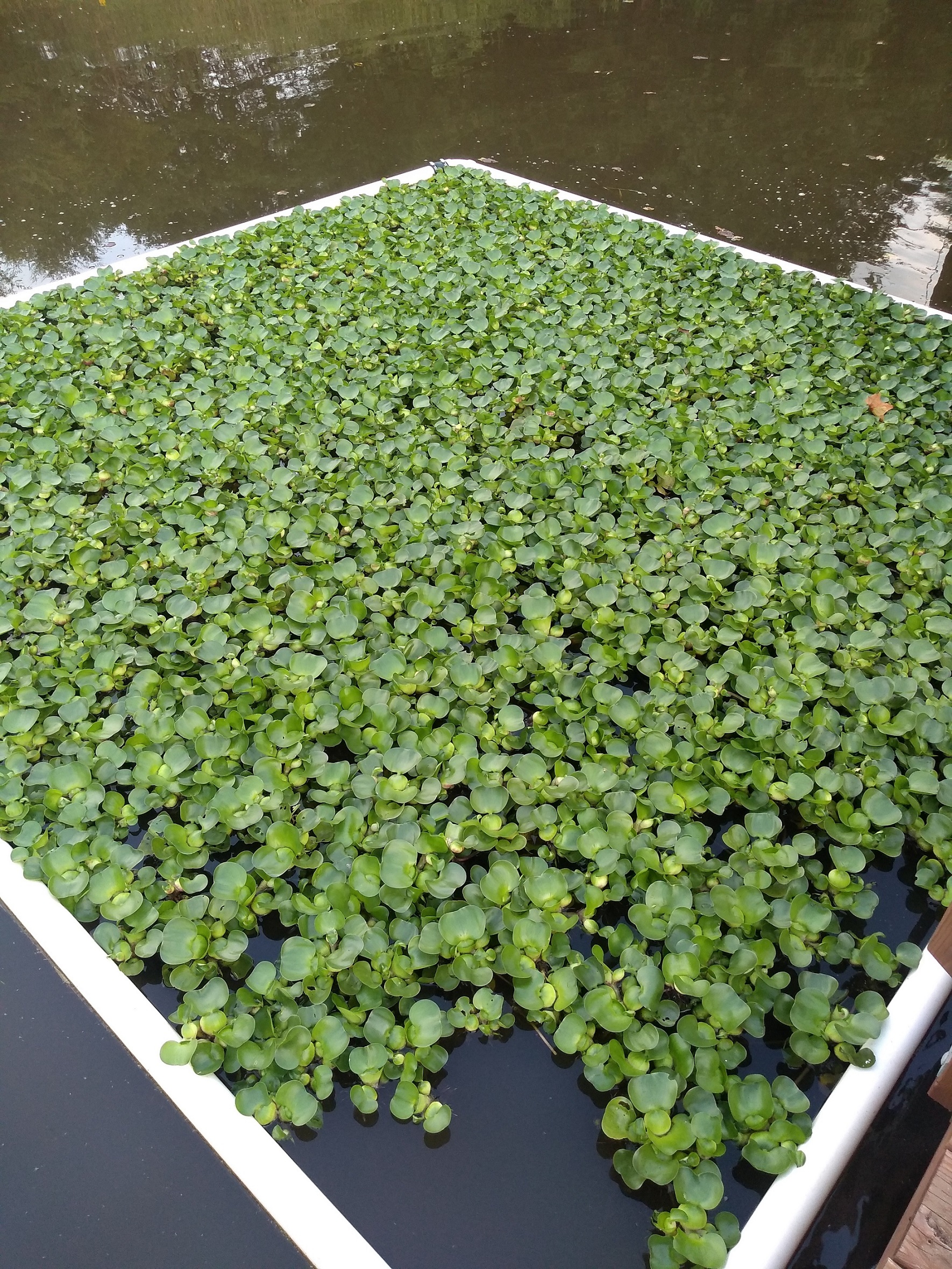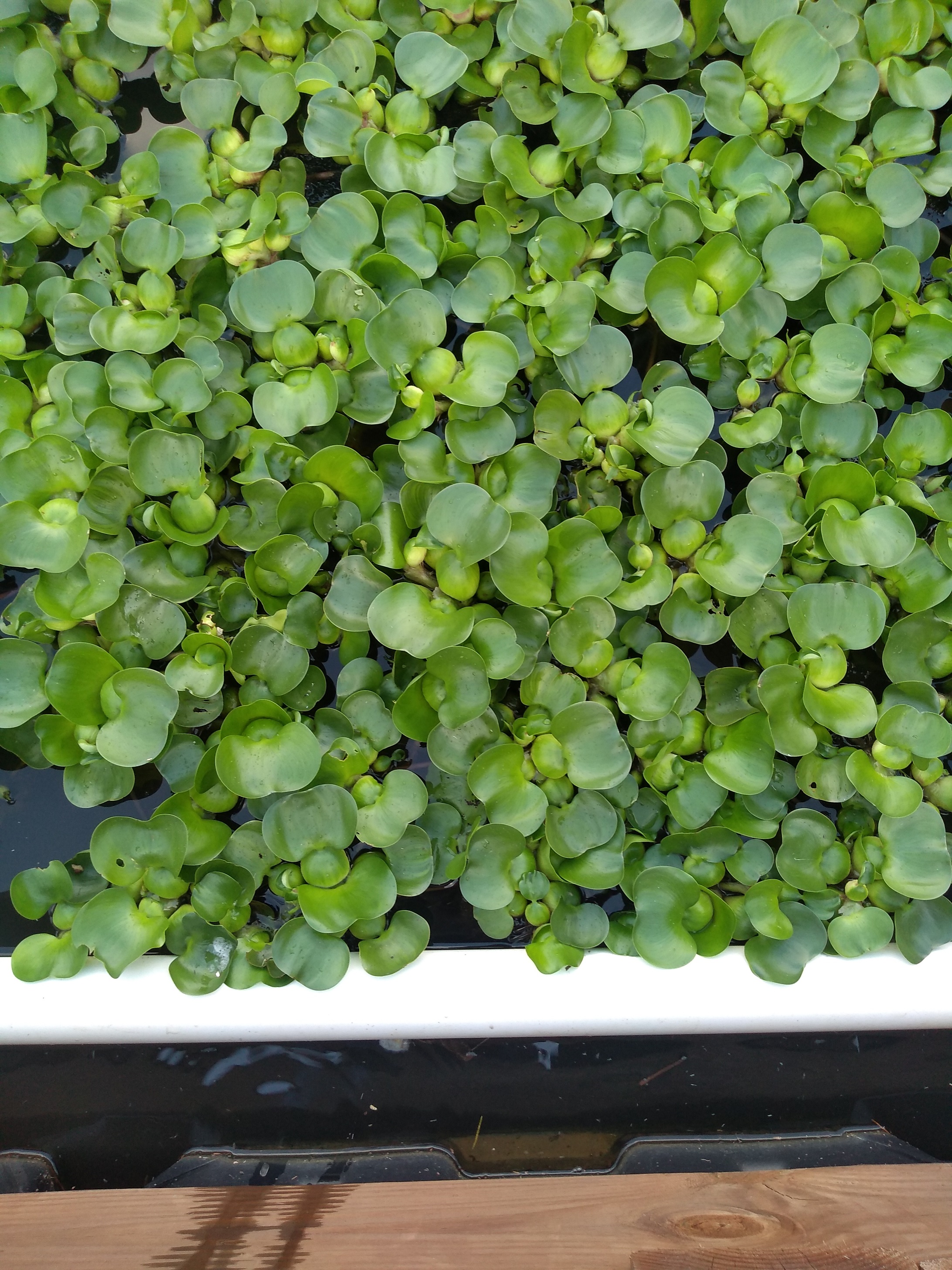I'm not sure how to quantify the amount of plants that would be needed to reduce the nutrient level in my 1/4 acre pond or how to describe the nutrient levels to begin with, so, I thought I'd start this discussion and see if it leads me to a new pond project for next year.
My pond is 1/4 acre, 10 foot at the deepest, with an average depth of about 6 to 7 foot (very steep sides). Secchi transparency started out this year over 36", but as soon as spring was in full swing it dropped to range between 18 and 22 inches ever since. I feel like the pond is running on the edge of a fish kill should an algae bloom get out of control. I feed this years 2 to 6 inch stockers daily about 1/2 pound in the evening and aerate from 9pm to 9am. The recent water temps are pretty consistent being 78 deg F at the bottom, 82 at 18" down and 86 at the top 6 inches.
Side note: The pond gets flushed out a few times during the rainy seasons so much so that the 15" drain pipe can get submerged. I am thinking that chemical or mineral treatment could be a waste of money especially during fall, winter, and spring.
I have thought about using water hyacinth and floating pvc containment corrals to help with nutrient levels, but certainly cannot afford the time to manage if a large portion of the pond would be consumed with floating plants.
My goal is to determine if the nutrient levels need babysitting and, if so, how many and what type plants wound be best suited. Thanks for reading through my windy post!
Hey Quarter,
I've been considering the hyacinth corral project myself. Our ponds are very similar, yours being slightly bigger. Sounds like they're built exactly the same tho. I started out the spring with around 18" visibility, but going into summer it increased to over 4 feet for several weeks of very dry weather. Now that we've gotten back to more consistent rains, the visibilty has come back to around 18-24 inches. I'll be installing aeration in the coming weeks and am interested to see how that affects blume and temps. I've had as high as 99 degree surface water this summer. Luckily, with a small deep hole, my mutts have been able to get below the heat.
I'm not sure how all this pertains to nutrients as I'm still very novice to pond life. My interest in the hyacinth was to provide shade and cooler water, as well as more hiding places for forage. I'd really like to be able to introduce some grass shrimp, but there's no place for them to hide currently.
I would think, with hyacinth being as prolific as it is, it would consume a lot of excess nutrients, maybe too much if not controlled, and your visibility would improve. Control is definitely the key tho. Left to it's own devices, your nutrient levels may plummet to the point of endangering your phytoplankton as well as any other wanted vegetation.
My less than $.02!!!!
I'll be installing aeration in the coming weeks and am interested to see how that affects blume and temps. I've had as high as 99 degree surface water this summer.
I bit of a highjack to my own thread (I guess I can do that)...I can't say what adding the aeration to my pond has done to the blooms as my old cattle pond is so freshly renovated that blooms have been heavy, consistent, and, at times, scary even after the diffusers went in. The water clarity (18-24")has been very consistent since adding aeration with the color varying every few days. But I can tell you that before the aeration system was added I had temperatures at the bottom in the lower 70's and surface temps in the mid/lower 90s. My pond has a lot of shade which helps temps, but is bad for wind action. After adding air, the bottom has risen into the mid to upper 70's, but the surface stays in the mid to lower 80's.
It makes since that if you raise the bottom temps by circulating the water, the upper temps will fall...until you over circulate and super heat the whole pond. I just run the air from 9pm to 9am right now.
I'll check my records (I take temps at the surface, 18" down and at the bottom by the end of the dock,7 feet down about every other day) and may post some "before/after air" readings.
Besides sideswiping my thread, I'm still interested in hearing from those hyacinth and/or water lettuce lovers.
Interestin info QA.
I've had my aeration in for 3 days now. Still breaking the pond in. Ran it for 4 hrs earlier, and have the timer set to run for 6 hours later tonight. I have noticed the water clarity has reduced a bit, which is probably from bottom silt. I'll need to check my surface temp when I get home tonorrow. It has been lingering in the mid 90s. It'll be interesting to see if its dropped any after a day of summer heat.
Last time I checked surface temp during hot afternoon it was 87. Hotter than fish like, but less than you are "blessed" with down in southern LA.
Hopefully we'll get some cooler weather soon. Up here we're still in a drought...
We got 1-1/4" of rain last night, pond is now 11" low instead of 12". I look forward to checking the temps this evening to see the effects (if any) and I'll try to remember to post the before/after aeration temp records.
I checked the temps last night and very little noticeable temp change due to the rain. The bottom was one degree cooler while the surface and 18" down were two degrees warmer. I can't conclude anything from that. At any rate, I have started a separate thread to document and discuss the before/after temp associated with my aeration start-up this summer. It's located here...
http://forums.pondboss.com/ubbthreads.php?ubb=showflat&Number=494996#Post494996I am still hoping to here from some hyacinth lovers...
I have had very good luck with water hyacinth. I have a 6 foot diameter floating ring made of PVC pipe with foam pipe insulation over that. Last winter I took 3 plants a friend had in his garden pond because they were just going to freeze anyway. I overwintered them in a bucket of water in a bright heated room and after last frost this year in early June, I put them in the ring. They looked pretty lonely in the ring, 3 plants and a 6 foot ring but this is a picture from mid July.
The ring is tethered to the bottom to keep it from drifting all about but it seems to attract floating duckweed which collects behind it. The good thing is it makes netting out duckweed easier.
I will remove some of the hyacinth soon to get the biomass out of the system and leave room for it to continue to grow until it gets cold. Then I will rescue 3 lucky plants for next summer and compost the rest.
[img:center]
http://forums.pondboss.com/ubbthreads.ph...7c08d6&f=15[/img]
Description: summer 2018

I have had very good luck with water hyacinth. I have a 6 foot diameter floating ring made of PVC pipe with foam pipe insulation over that. Last winter I took 3 plants a friend had in his garden pond because they were just going to freeze anyway. I overwintered them in a bucket of water in a bright heated room and after last frost this year in early June, I put them in the ring. They looked pretty lonely in the ring, 3 plants and a 6 foot ring but this is a picture from mid July.
The ring is tethered to the bottom to keep it from drifting all about but it seems to attract floating duckweed which collects behind it. The good thing is it makes netting out duckweed easier.
I will remove some of the hyacinth soon to get the biomass out of the system and leave room for it to continue to grow until it gets cold. Then I will rescue 3 lucky plants for next summer and compost the rest.
I can't tell from the picture; are the plants sitting on something? Or do they just float inside the open ring?
Good Question DrLuke, AND, do they ever escape ?
EDIT: The last thing I need to be doing is chasing rogue plants around the pond come fall. Not to mention the potential for taking over the pond.
I continue to look for ways to mitigate nitrogen washing into my pond, as it is fed from Ag run-off across the road. I have sediment ponds on both the inlet fingers, but am not sure what if any impact this is having. I've looking into the floating island of plants concepts, to potentially use in the sediment ponds OR in the inlet fingers where water flows in.
Something like this:

The primary downside is expense. The biohaven islands shown above cost $35 per square foot. So even a relatively small 7' x 5' island is 35 ft square, which would be $1225. That's before adding plants!
So, I've been thinking of experimenting with 'something else' to float and plant on. Any of our plant biologists have some hard earned experience to share?
I actually have a floating tangle of logs that broke free and floated around our pond this Summer. It is 100% made by Mother Nature. The logs are webbed together with some type of sedge grass that grows along the banks of the pond. Watching it float around this year really made me think it would probably be pretty simple to build a DIY floating island. I meant to take a pic of it, but never did. I'll try to get one in September.
Dr. LUKE / QA,
Hyacinth are self floating as their stem system has bulbous bases and act as flotation. If you cut it open, it looks like closed cell foam inside. No need for any kind of screen or platform. Just a ring of some sort to keep them contained.
As to whether they ever escape, that's always a possibility and if you're not able to keep tabs on them at least monthly, you could have a problem as they are very aggressive. I've seen them completely choke canals in the marshes here to the point of being impassable. (Thats where I plan to get mine) Containment, in my mind, should be relatively easy tho with a ring with high enough sides. I'm considering using 1" PEX laced thru 4" pool noodle to make a ring, anchored out in front of the main spawning area.
The upside is they provide loads of shade and provide excellent hiding habitat for small fish and grass shrimp as their roots hang down a foot or more under water. How much nutrient load they consume....no clue. But they sure do grow fast and down here...all year long.
My understanding is that WH leaves seeds around and keeps spreading and coming back. I'm not convinced a ring can really confine it?
At least here in The South, WH is too scary and illegal to use in a decent sized pond. (Class B misdemeanor in Texas for possession.)
The plants are floating in the water contained in the ring, when I want to pull some out I can row over in my boat and fill a basket or at the end of the season, I untie it from its mooring and tow it to shore to empty it out. Never had a plant escape and there are no rogue plants floating in my pond. The roots interweave and the chances of an escape are even less.
I understand water hyacinth can be invasive but up in northern Pennsylvania it gets cold enough for long enough (sigh!) that they die off. So even if a few did escape they won't survive the winter. The big plus is they absorb nutrients but are easily removed from the pond before the freeze so they don't release their nutrient load back into the water. They give it to my compost pile.
Does anyone know what the matrix is for the plant base to float in on a floating island?
The plants are floating in the water contained in the ring, when I want to pull some out I can row over in my boat and fill a basket or at the end of the season, I untie it from its mooring and tow it to shore to empty it out. Never had a plant escape and there are no rogue plants floating in my pond. The roots interweave and the chances of an escape are even less.
I understand water hyacinth can be invasive but up in northern Pennsylvania it gets cold enough for long enough (sigh!) that they die off. So even if a few did escape they won't survive the winter. The big plus is they absorb nutrients but are easily removed from the pond before the freeze so they don't release their nutrient load back into the water. They give it to my compost pile.
It would seem no floating substrate would be needed then for water hyacinth. I'll have to see if the Iowa DNR has an opinion on their use. Thanks for the info!
Makes sense. Not an option down here. I find WH to be very attractive, too bad it can't be managed in The South.
It seems safe for most of the U.S. to use. Note I said most. Here is a map that shows the "bad" areas to try to use the plant. Discalimer: other areas may be illegal to have as well.
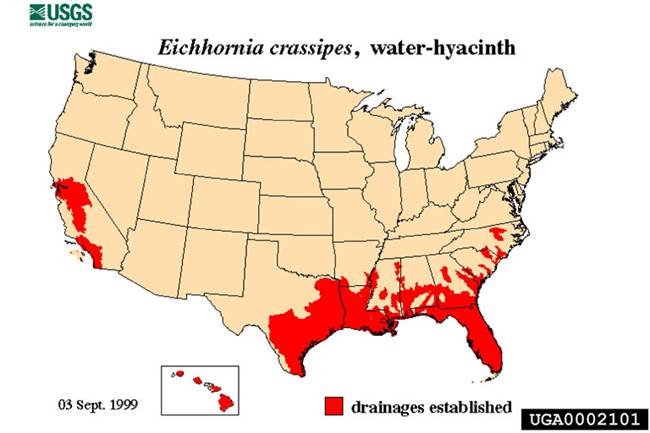
Kelly Duffie posted it back in this thread...
http://forums.pondboss.com/ubbthreads.php?ubb=showflat&Number=267151Now, My question is...If I remove, let's say 100 pounds of Hyacinth from my pond at the end of the growing season,...did all that mass come from my pond water? If so, that seems like a LOT of nutrient stuff being removed. But I have heard (somewhere) that plants get some of their mass from the air. Any vegetarians out there?


Water hyacinths increase water evaporation and water temps, though they do furnish good cover for YOY fish. Very aggressive, I do NOT recommend their use unless you are in cold climate.
By the way, if you take out WH, be prepared to see it come up again the following summer. It sends down seeds that can germinate for up to 14 years!
Quarter Acre. Photosynthesis makes simple sugars such as glucose and fructose (C6 H12 O6). These are combined to make polysaccharides including cellulose. This is what a 2x4 is made of.
Inputs for photosynthesis are water (H2O) and carbon dioxide (CO2) plus light. Oxygen is released as a byproduct.
Cells of a plant, like an animal are mostly water.
So almost all of the plant, even a redwood, starts as water and air. It also burns or decomposes back to the same.
Nutrients allow for the complicated stuff like proteins, electrolytes and such that make all this work.
Anthropic and Vortex, Thanks for chiming in, that's some good stuff to think about.
By the way, if you take out WH, be prepared to see it come up again the following summer.
anthropic,that sounds pretty scary! Why are they not considered invasive in Missouri? I can imagine the creek down hill from my pond getting taken over and all the way to the Missouri River. I'd feel soooo bad!
Vortex, So, the plants get their mass from everywhere. I can get that, but any idea how much, ratio-wise, comes from the pond water. I guess that I am trying to generate an idea of how much plant-life is needed to reduce "X" amount of nutrients. IF, for example, it takes 1000 pounds of plants to "suck up" 5 pound of nutrients from the pond...why bother?! My back does not have it in it.
By the way, if you take out WH, be prepared to see it come up again the following summer. It sends down seeds that can germinate for up to 14 years!
I would assume that is limited by just how cold your winters are. Here in Northeast PA it isn't uncommon to see 18" of ice on the pond in winter.
Looked at the plants earlier and they are flowering! Nice purple flowers. So if they are about to produce seeds I expect they will be in there next summer. I will keep an eye out for returning plants outside of the ring next summer. I've got to get out there with a camera and take a picture.
I spoke to the guy who gave me the plants from his garden pond. He told me his flower every summer and he doesn't always get new plants (for no reason than he forgets to do it) and has never had new plants just arrive from seed.
As Kelly Duffie as referenced in another WH thread, these are called "Fatal Beauty" in areas where they are invasive.
[img:center]
httphttp://forums.pondboss.com/ubbthread...5bed3e&f=15[/img]
I can see why!
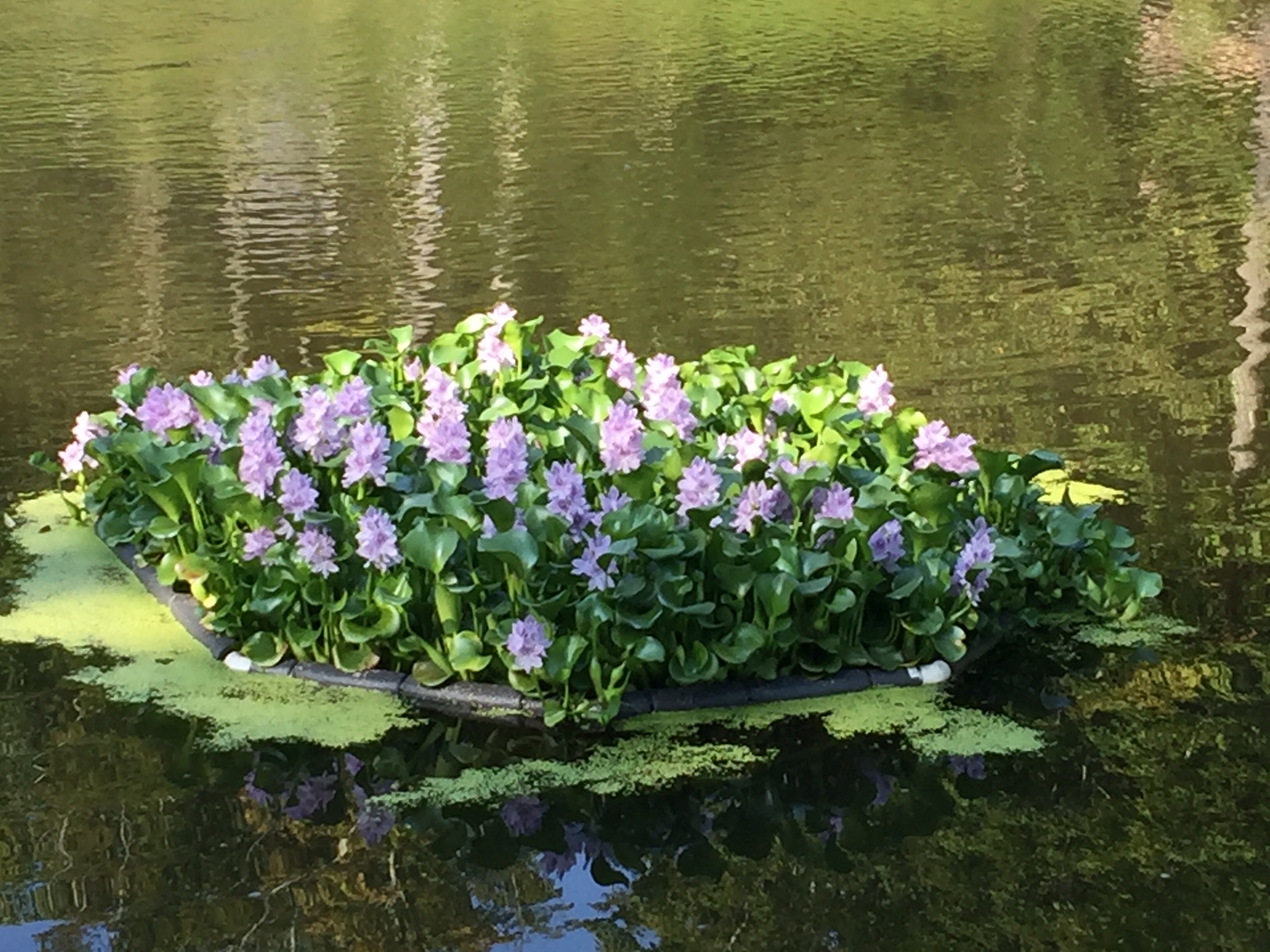
Inputs for photosynthesis are water (H2O) and carbon dioxide (CO2) plus light. Oxygen is released as a byproduct.
Cells of a plant, like an animal are mostly water.
An interesting side-note: Contrary to conventional assumptions, the O2 released during plant photosynthesis isn't sourced from the CO2 input. Instead, the released O2 originates from the H2O input.
So, the plants get their mass from everywhere. I can get that, but any idea how much, ratio-wise, comes from the pond water. I guess that I am trying to generate an idea of how much plant-life is needed to reduce "X" amount of nutrients. IF, for example, it takes 1000 pounds of plants to "suck up" 5 pound of nutrients from the pond...why bother?! My back does not have it in it.
As referenced by Vortex, a plant's live-weight mass is largely comprised of water. When assessing or quantifying a plant's nutrient reduction efficiency, dry-mass (after desiccation) is the measure upon which to focus.
QA's simple question is a good one. How much "nutrients" am I removing? This is sort of like trying to generate a nutrition label for the plant you are removing. No idea how to do this in practice although green leaves usually suck up nitrogen. Roots and fruits need more phosphate.
I'm guessing, but there is probably one nutrient limiting the growth of the plant you are trying to slow down (photoplankton?)
Reading, mostly here, it seems that phosphates are assumed to be the limiting factor. If you wanted to slow your lawn you would probably focus on nitrogen.
I have no idea how to reduce phosphorus availability although adding lime makes it more available.
I'll bet a guru knows of something that binds with phosphates and either precipitates them out or reduces their bioavailabilty. Just need the right guru to scan this thread.
Aluminum sulfate will bind P, as will lanthanum (a rare earth element found in PHOSLOCK).
I took a WH plant from the pond today and placed it in a tared pie tin to dry out in the greenhouse while I am away for a few days.
When I get back I will fire up the Big Green Egg to 250º and completely dry the plant and re-weigh it.
I'll post the results here and maybe some of the experts can shed some light on just how much nutrient they pull from a pond. (If they are physically removed before they die off)
I tried microorganisms to eat up the excess nutrients and that turned out not so good, I think. I wound up using Alum Sulfate as Mr Duffy explained to tie up the excess phosphates and drop them out to the bottom of the pond. Worked pretty good. My excess green water with about 9 to 10" of visibility cleared up to around 36" for a few days to where it is now around 24" during the summer months. I have been trying to get some beneficial plants going in the pond for the past three years. For what ever the reason is, it's been hard to get plants established.
If one would take "X" amount of Aluminum sulfate (or lanthanum), enough to clear the water, let's say, by 24"...How many pounds of Hyacinth plants would do the same thing? I will likely try the hyacinth plants just because I like plants, but it would be nice to know how many would actually make a difference. My goal is to improve clarity so that I can get away from the 18 to 24" visibility. I believe this range is close to a point that problems may occur so taking the clarity to 36" improves my ponds aesthetics, leaves plenty of nutrients for a healthy pond, and reduces the risk of a large bloom die-off/D02 crash.
[quote=anthropic]Water hyacinths increase water evaporation and water temps, though they do furnish good cover for YOY fish.[quote]
Anthropic, how would the Hyacinth plants increase pond water temps? I would have guessed the opposite.
And does the seed germination aspects you speak of apply to areas well outside the red zones on the USGS map posted earlier?
PS: PaPond - I look forward to your test results...Thanks!
Here in E Texas and N. La American pondweed seems to reduce nutrients and help to clear up the water from what I have seen. But as I understand it, it can be invasive in certain parts of the country or if the pond is more shallow than deep. For me, I would much prefer the pondweed over the Hyacinth. And every time I hear Bob Lusk mention good plants he talks about American pondweed.
I am sure pond weed has its place and I can appreciate it in a larger BOW especially wrt boat fishing. But, not being botanically minded, how would APW reduce the nutrient levels unless you physically removed the dead and dying submerged plants at the end of the growing season? I would prefer not to go swimming and raking in the fall. The hyacinths would appear to be more easily removed periodically.
QA,
Have you considered 'for every action there is a reaction' and what that might be?
Your visibility problem may not be so bad. It sounds like you want your pond to look more like mine, and I, yours. My pond, I can see bottom in six feet of water. The problem - seaweed is thriving in depths past ten feet deep and mats are forming on the surface. The plants keep the water clear, so much so that, an algae bloom cannot get going which would help to block light that would otherwise keep the seaweed problem at bay.
I'm working to reduce nutrient levels as well, but at the bottom layer, a couple treatments of beneficial bacteria pellets (Muck Away)so far this summer to help reverse decades of partially decaying organic matter. The goal for me, to slow down the seaweed and to get an algae bloom (like yours) to block the light from reaching the bottom to keep it that way.
Journey, You and I are definitely trying to meet somewhere better in between. Everyone wants a clear pond until they realize that there can be unpleasant consequences. I am basing my concerns on two "rules of thumb" (and my tendency to worry a bit too much). I have read/heard that a consistent 18 inches of clarity can be considered to be on that fine line between a healthy nutrient laden pond and the potential for a algae bloom die-off/02 crash. I have also gathered that water temps near the 85 degree mark are also considered "fine line" with respect to fish/pond health.
I would like to back off that fine line to a place where clarity is more like a consistent 24 inches with temps around 80 instead of 18" and 85 degrees F. Nutrient absorbing plants to help clarity and (maybe???) to create shade to help keep temps lower seems like a nice direction to explore. I would still like to hear about how hyacinths (or any type of plant) can increase temps.
Have you considered 'for every action there is a reaction' and what that might be?
With the theoretical benefits of the hyacinths, should the pond get too clear, I would think that removing the plants would allow for the pond to revert back. My biggest obstacle, at this point, is how many sqft of plants to start with and is that amount more than I care to deal with.
This exercise may be impossible because I, personally, am starting this quest with little to no intellect on the subjects of biology and botany. I know the watershed is cattle pasture that gets moderately fertilized once yearly and that the pond gets a lot of flow during the rainy seasons (fall, winter, & especially spring) under normal rainfalls. It tends to start the year off pretty clear (36") and then turns shades of green and brown as summer endures (18"). My logic tells me that the water should clear up as summer fades due to the lack of nutrients being introduced (from the lack of rain run-off) and the growth of vegetation along the shore and algae blooms soaking up nutrients, but it just stays around the 18" mark with the exception of an early bloom that results in a crazy green colored water early.
I weighed up the dehydrated hyacinth I grew in my pond.
Water hyacinth placed in a tared pan straight from pond, water shaken off. Plant start weight 266 grams
After drying out in the greenhouse I placed it in my Big Green Egg at 250º for 2 hours and the resultant dehydrated plant material weighed 11 grams
End result the plant was 95.87% water.
I sectioned off my plant ring (6' diameter) and counted the plants (one stem per plant) to figure out the total number of plants in 1/4 of the ring. Plant count was 87 plants. Figuring each plant (very similar in size) has a dry weight of 11 grams that's 348 plants times 11 grams = 3,828 grams, or 8.4 pounds of dehydrated biomass that won't settle into the bottom of the pond this winter.
Is it worth doing this, I think so, other more scientific opinions?
I weighed up the dehydrated hyacinth I grew in my pond.
Water hyacinth placed in a tared pan straight from pond, water shaken off. Plant start weight 266 grams
After drying out in the greenhouse I placed it in my Big Green Egg at 250º for 2 hours and the resultant dehydrated plant material weighed 11 grams
End result the plant was 95.87% water.
I sectioned off my plant ring (6' diameter) and counted the plants (one stem per plant) to figure out the total number of plants in 1/4 of the ring. Plant count was 87 plants. Figuring each plant (very similar in size) has a dry weight of 11 grams that's 348 plants times 11 grams = 3,828 grams, or 8.4 pounds of dehydrated biomass that won't settle into the bottom of the pond this winter.
Is it worth doing this, I think so, other more scientific opinions?
I'm seriously considering hyacinth. My pond isn't very big and being theyll be contained, even if they escape, they'll drift to the windward side of the pond where they ca be raked out.
They awfully pretty, and i can can get them easily at no cost
Good work PaPond. They are very good at sequestering nutrients. In areas where the pond has ice they should not sprout after a freezing winter. The will clear the water and compete with phytoplankton and FA. There is very likely something in the literature about the nutrient content of the water hyacinth.
Thanks for the vote of confidence Bill.
I'm hoping to kill three birds with one stone here (hope I'm not being greedy). Both islands will be a combined 48 square feet of surface area. My plan is to anchor one over deeper water, out from the main spawning area, and the other on the opposite side of the pond.
Once established, their root systems will dangle beneath the wire floor, providing cover for YOY, fry, GAMs and hopefully some grass shrimp, while also consuming nutrients, and proving some much needed shade during the summer. Those days of 99* surface temps get a little unnerving.
Mike, Are you doing the WH thing this year?
I have ordered a a few and will be giving it a go.
I think I will start off with some 1" Pex line hula hoops to see how they get started and then upgrade to a light duty pvc rectangle anchored to the side of my gangway. If I get that far, a second rectangle will be deployed on the other side of the dock. This way I can cull them from the dock and not mess with getting the boat out...if I'm lucky and they don't escape!
At any rate...A big thanks to the participants in this thread and post some pics of your WH islands if you can share. I haven't bought any PVC yet, maybe someone has a better/cheaper way.
Well, it turns out that I didn't have any scrap 1" PEX, so I bit the bullet and spent the $40 to put together a 10 foot square out of 2" PVC DWV Pipe. If this fills up with plants quickly I'll make a second one and see what happens. I opted to add rubber splice connectors at each corner so that the corral could be broken down and stored more easily through the winter.
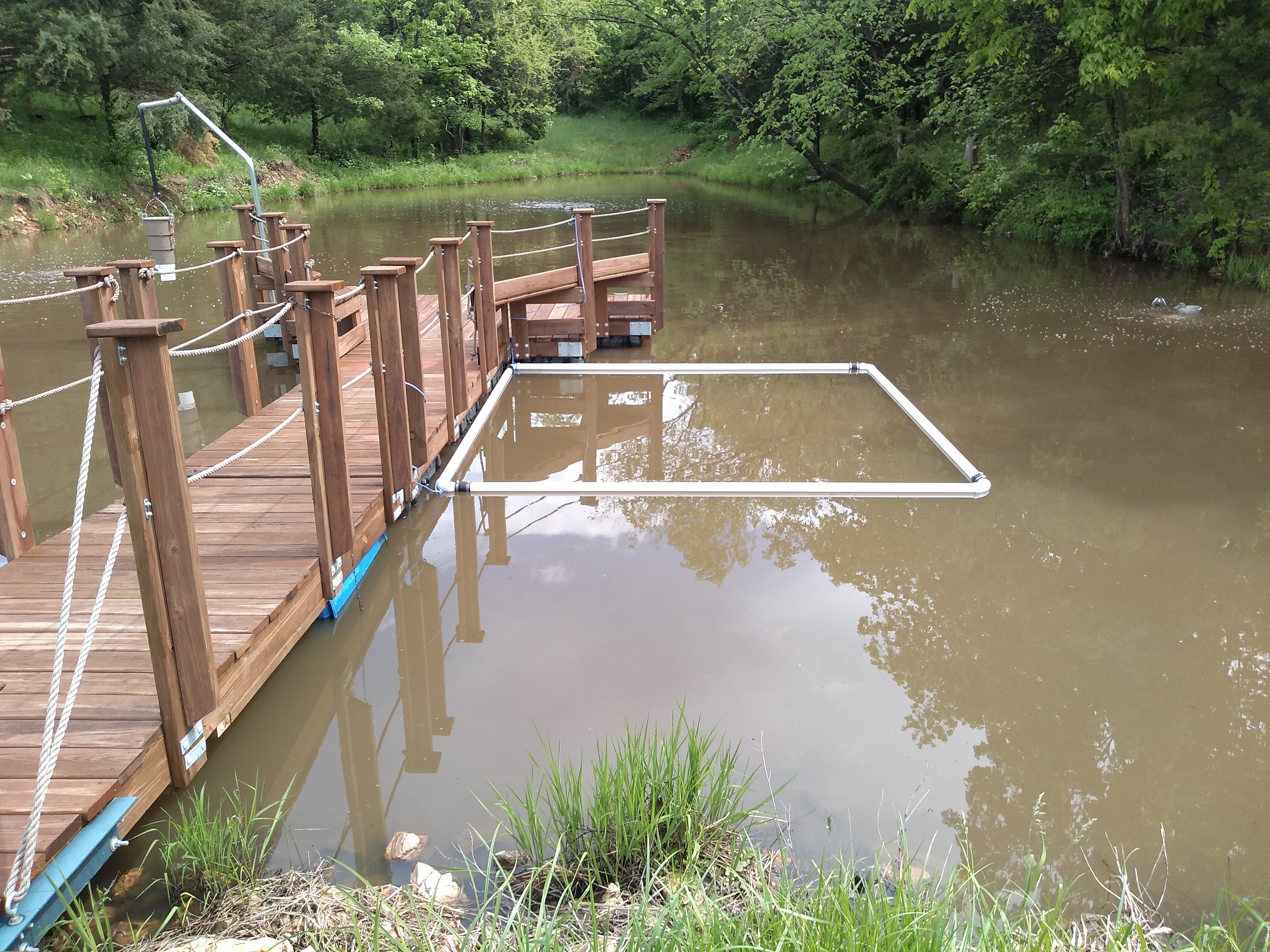
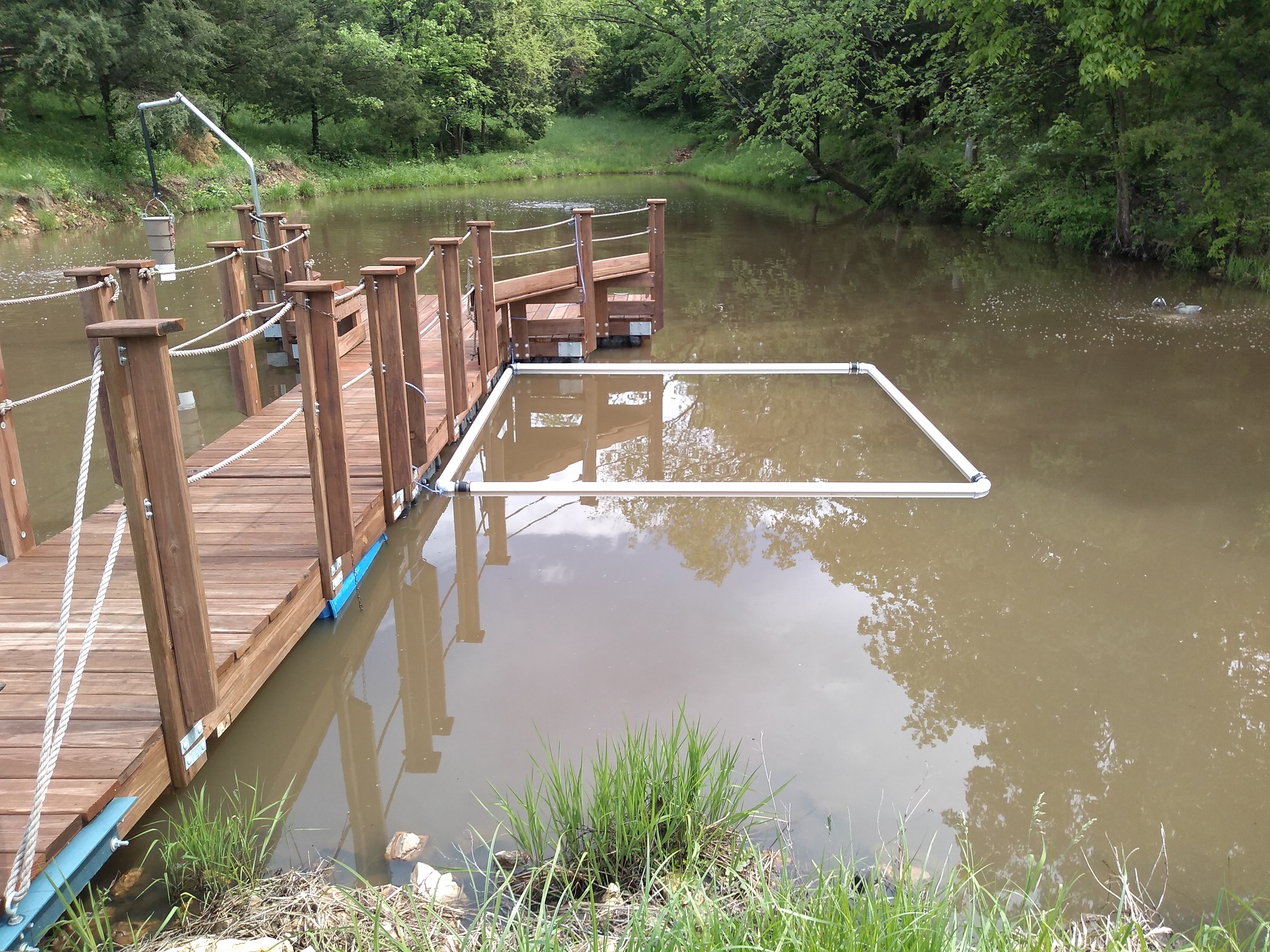
UPDATE: I received the WH and kept them in a bucket for a week or so to watch for duckweed hitchhikers and the like (none found). All 4 of the WH could have been stuffed into a regular sandwich bag upon receiving them. They have been in the PVC corral now for about three weeks and I don't think you could stuff them in a gallon zip-lock now. The water temps were in the low sixties when they were put in the pond and the temps are now pushing 80. I think their growth will accelerate as the pond continues to warm up.
I can assure you...they will!! That corral will likely be full by the end of summer.
I'm really hoping that I have to make a second corral AND that I have to cull plants out...we'll see!
I would love to put them in my pond, but down here they grow too aggressively and once they drop their seeds there's no getting rid of them. I can show you canals in the marsh that have been completely choked closed with them.
I'm still looking for something that will float like hyacinth and can be corralled but so far all I've found is water lettuce and I'm not sure if they're considered invasive here either.
Edit: water lettuce is illegal in Louisiana as well as hyacinth.
will grass carp eat the hyacinth? Thanks!
will grass carp eat the hyacinth? Thanks!
I don't know first hand, but the web says that the GC will eat them, but the GC is not recommended as a control device. I don't think they could keep up with the WH's reproduction rate in areas where it is a menace.
The real question might be...do they prefer them over what is already available in your pond?
Thanks QA! I was thinking about giving this a chance. My watershed is all Iowa farmland and I am hoping this will take out some nutrients. I just purchased this land last year and unfortunately the previous owner put several GC in years ago.
David, The jury is still out on how much the WH will reproduce in my pond, but if carp are a concern, I imagine the "corral" could be basketed with chicken wire & zip-ties pretty easily.
I'd consider doing that anyway. Not just chicken wire, but screen on top of that as well to try to catch any seeds from being deposited in the pond...just in case you decide WH was a bad idea.
Been researching this plant a bit in hopes to maybe try it in my pond. Wouldn't you know it...it is also illegal in La as well as Ca. Looks like I'm going to have to go with lilies.
Side note: I did find out the Botswana can either be planted or allowed to just float freely.
This photo was taken 5 days ago and all these plants would have easily floated in a five gallon bucket when they arrived. They are floating in an approximate 2 foot square in the pic. I'd say they expand rather quickly and the South Africa-type weather is not upon us yet.
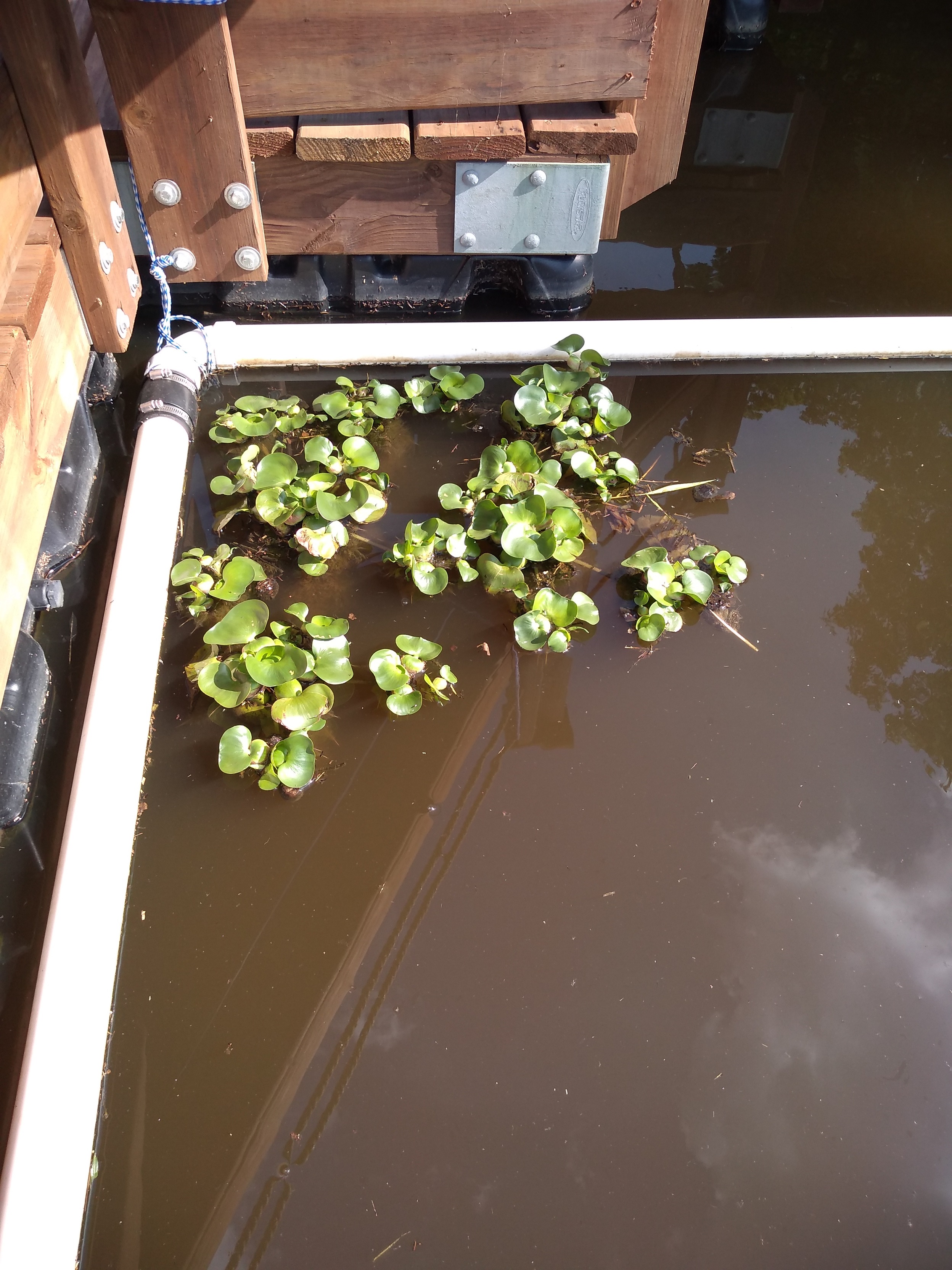

Following this thread. This is interesting stuff and the reason I return to PB every day to read threads. Thanks for putting this together.
Nedoc...I'm flattered to have an interested party in my "stuff". I enjoy compiling it, so enjoy!
I did find an article where hyacinths were used to battle high nutrient laden/polluted waters...
"STRIKING A DEAL WITH THE WEED FROM HELL" by Garry Hamilton
https://www.conservationmagazine.org/2014/03/water-hyacinth-in-kings-bay/The above article says that they used the WH to cover about 1% to 7.5% of the water's surface in multiple Large BOW's and recorded very good results. Some of the results were argued, but it's all I have found to base my little pond ramblings on.
At any rate, 7.5% coverage on my 1/4 acre pond amounts to about 1100 square feet. That equates to 11 of my 10 foot square corrals. I don't think I have it in me to spend the additional $400 for the corrals, sacrifice the surface area of my pond, dedicate a boat for maintenance, spend the time culling plants, etc, etc.
But 1% of my surface are is just a bit larger than one of my corrals. So, I will stick with my original plan and count on making a second corral should this one fill up quickly and reap arguable results all the while enjoying the flowers. If this one corral does not fill up quickly, I will throw and extra $20 at plants at the beginning of next season.
On a side note: dlowrance (fellow PB member) has stated that his WH (located in central Illinois) come back every year from seed (some years more so than others). By my estimations, him and I are in the same plant hardy zone (or very close). Next year will will be interesting at my pond to say the least to see if these crazy plants make me crazy (er). And, anthropic can tell me "he told me so".
Here's the thread where Dale talks about his WH...
http://forums.pondboss.com/ubbthreads.php?ubb=showflat&Number=507304#Post507304
I have added some as well, they are growing and multiplying. I just put some foam floaties around a hulahoop I had laying around and it is currently just floating around the pond. I will keep watch on them.
Dave
10 days later from the last photo...

I'd say they like it in the pond!

Wow, that's some impressive growth! I'll be following your story, as I'd love to get rid of our GC and try something similar. I'm very curious to see if they'll come back next year, because I think I'm only a little North of you.
I'd estimate they've at least doubled in 10 days. I hope you can take some more update pics as we go, because now I'm also wondering if they'll keep growing linearly at roughly the same rate, or if they'll keep doubling (exponentially) for a while. My naive intuition thinks they might grow in more of a logarithmic fashion, with growth flattening out as the nutrient levels drop, but we'll see.
QA...what you have now will probably double again in 10 days. That corral is gonna be chockerblock full in no time.
I had never given this idea much thought but I have a buddy down the street with a water garden/green house that I found out today he throws about 50 lbs of these a month in the dumpster.
Needless to say, I'm trying to figure out what type of containment will work best for me. I don't have a protected dock area-yet-so not sure how well I can contain them with the winds I'm subjected to fairly frequently.
We shall see.
Edit: I asked him if I could come get a few and when I got there he had 5-5gal buckets full.. %-))
Drew - I think the logarithmic growth pattern will likely happen due to the plants running out of summer weather long before they run out of nutrients, but that's what this exercise is all about...we'll see! I'll continue posting photos as they progress and I may not be very happy if they return year after year, I bet I would consider the experiment a bust as I might have to apply herbicide to keep them under control - I'm not into that.
Mike - I believe I will have to make another corral soon.
Snipe - You'll be my new best friend if I can talk you into sending me a bunch of your neighbors throw away plants next spring, my cost, of course. That way I start out a little ahead of the growth curve and the corrals fill up sooner. My pvc corral seems to be doing it's job so far. I get little wind action at the pond, but heavier storms have come through and no rouge plants. You might be able to section off a corner of your pond with a straight section of PVC pipe or make a corral and just tie it off to the shore in a couple of places. You would want to make sure it's out far enough so that water level fluctuations do not strand it on shore and create an escape route.
Very cool and interesting project!
QA...I hope you can keep them all in two corrals!!
Foe deciding to try this this am.. some things happen quicker than others..
Pool noodles, 1/4" rope and 8 1-1/4" nuts.




Got a start anyway. Looks like about 7-8 big plants in each 5 gal bucket so 35-40 put in total before I left.
He says come get whatever I want so probably can send a few if you want some QA, happy to help.
That looks promising! You have gone from zero to hundred in one day. I'll be remembering you next spring for a lesson in going from 0 - 100. Thanks Snipe!
You guys have me so jealous. If I could figure out how to keep their seeds from falling into the pond, I would love to have them. In this subtropical environment, just as soon as I did, next year I'd be able to walk across my pond on top of them.
I did receive 5 hybrid lilies from Texas today and they are now permanently residing on its banks. Tomorrow I'll be looking at placing some fencing around them to keep the turtles off of them until they get better established. That or start shooting turtles!!
These plant are really going crazy!
A quick recap and added recent photos...
June 7th...

June 17th...

June 26th...
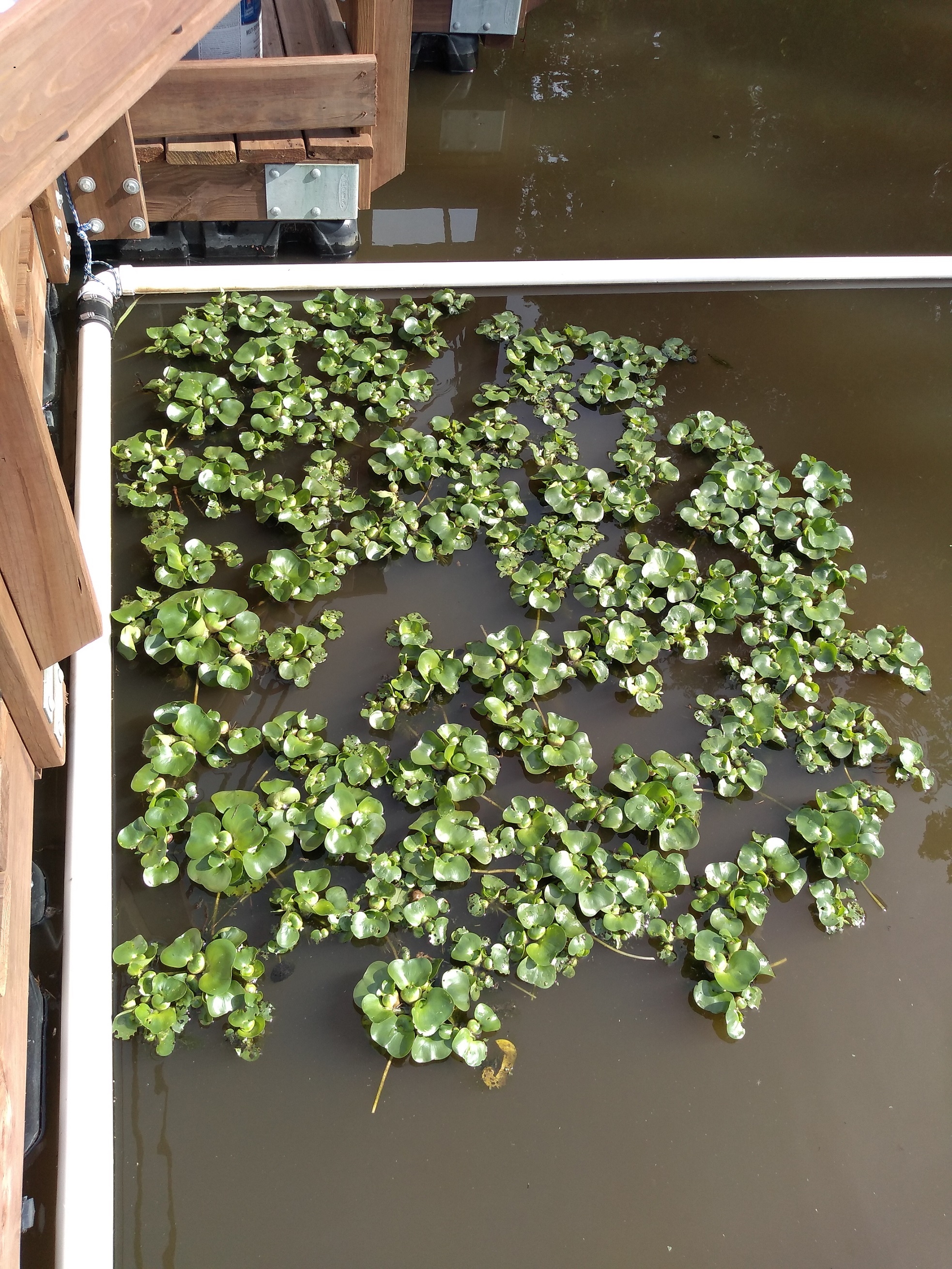
June 30th...
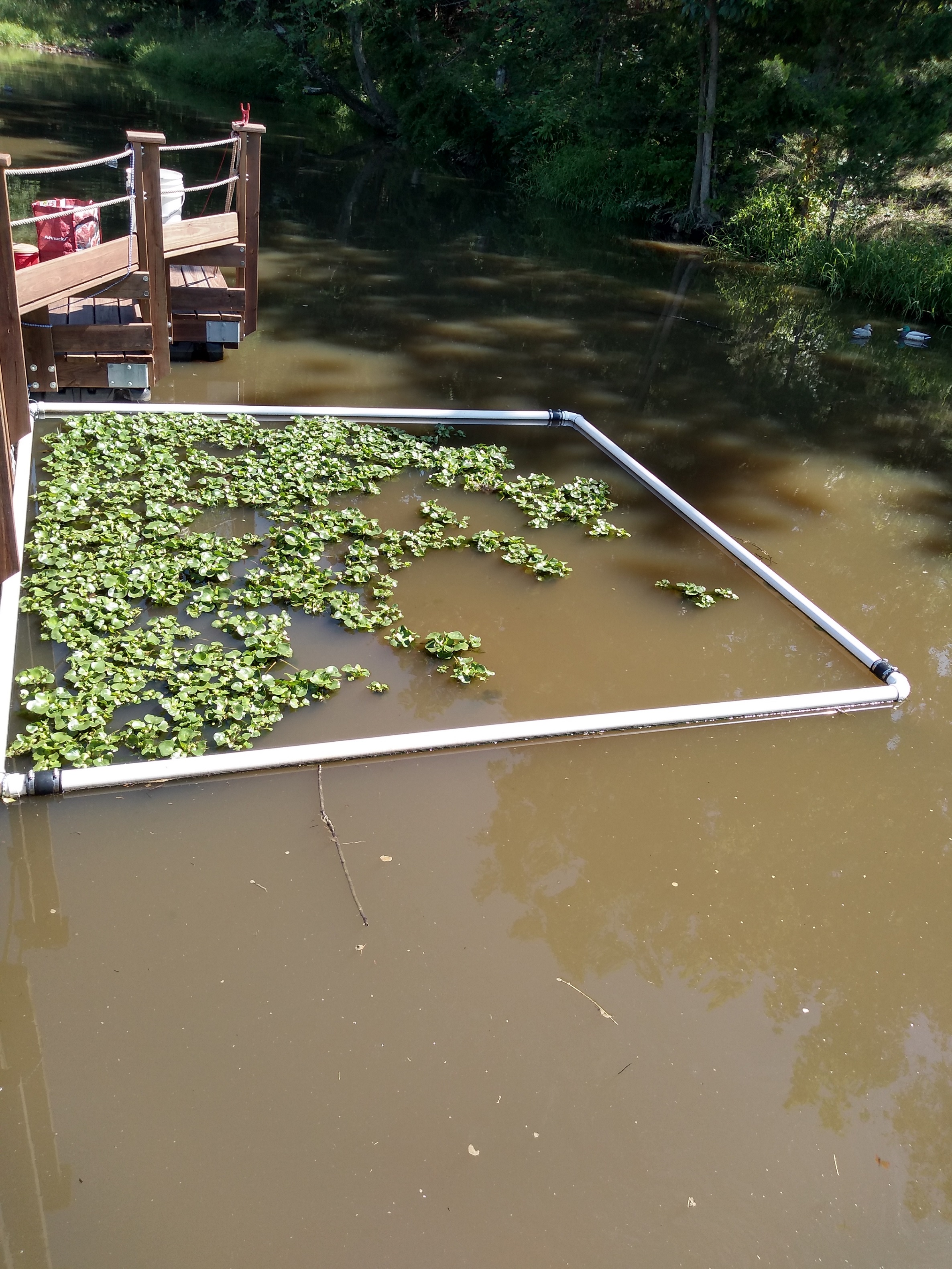
They are really liking the warmer water and summertime sun. Water temps are pushing 90 at the surface.
I think I will be buying supplies to make the second corral this week before they get out ahead of me.
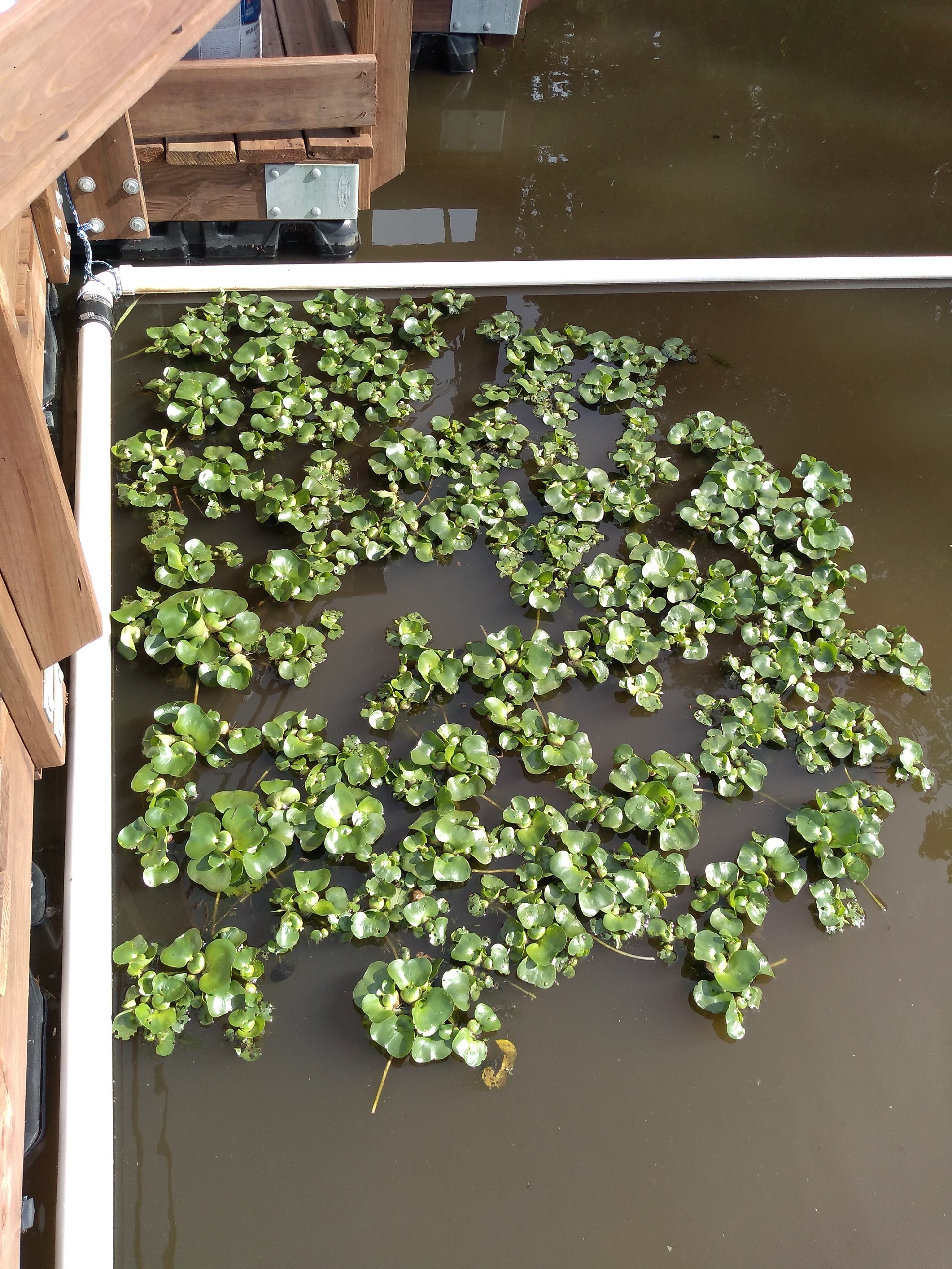
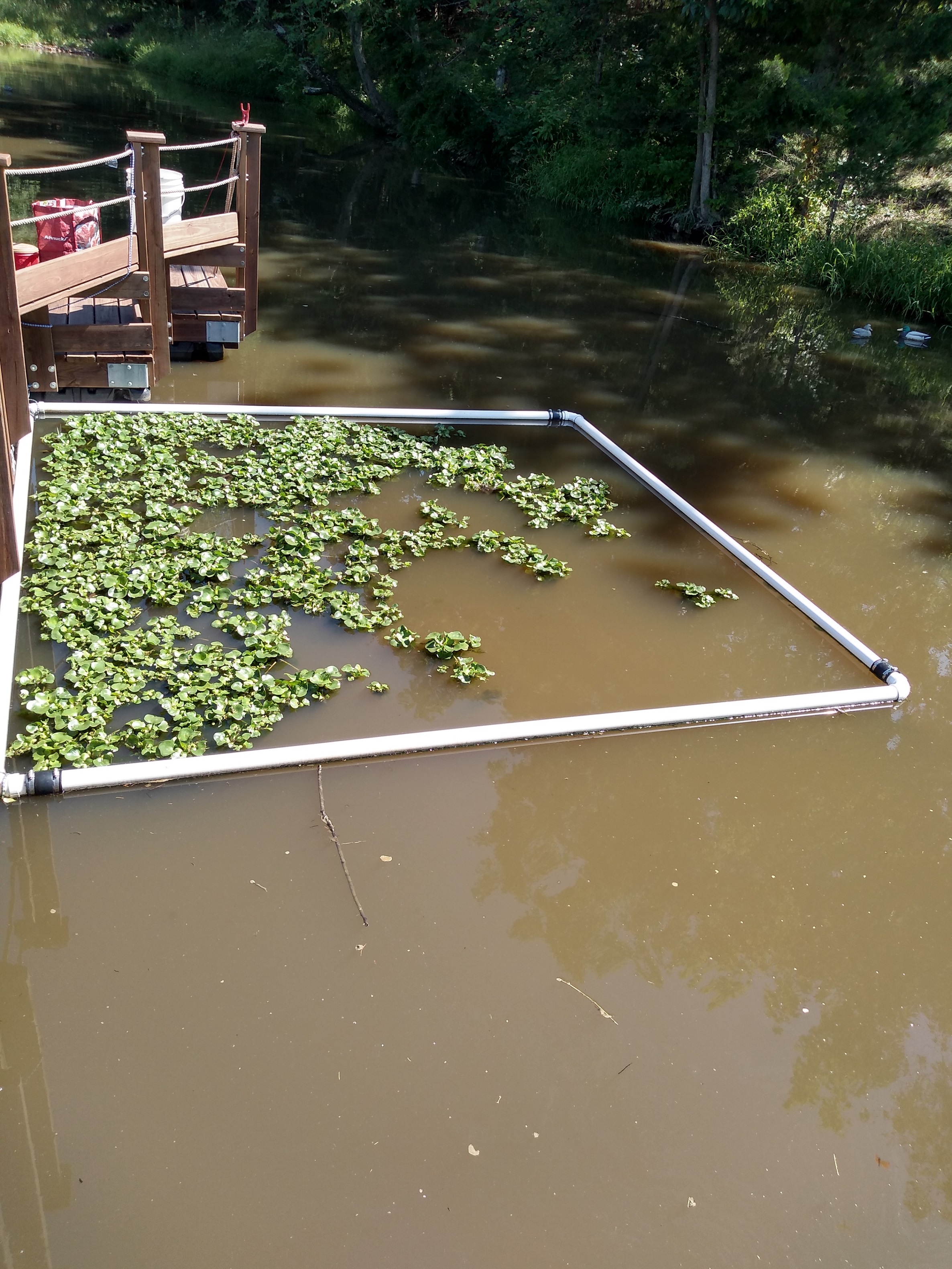
Wow!!! Your plants are multiplying quite a bit faster than mine.. Must be the variety.
Looks good!
I don't really know much about the varieties of hyacinth, but mine are supposed to be Eichornia Crassipies and it would seem that they have not been hybrid/domesticated (or whatever) into many varieties like most common garden plants.
I can presume that my pond has high nutrient levels and warm surface temps that these plants really like.
I can see how those might be a problem if they got loose in a pond.
I expect they will look really nice when they start blooming.
Well, I made another 10 x 10 corral...This photo was taken July 3rd right before I split the plants between the two corrals. I'll be posting another photo soon as both corrals are almost full to the point of needing to be culled.

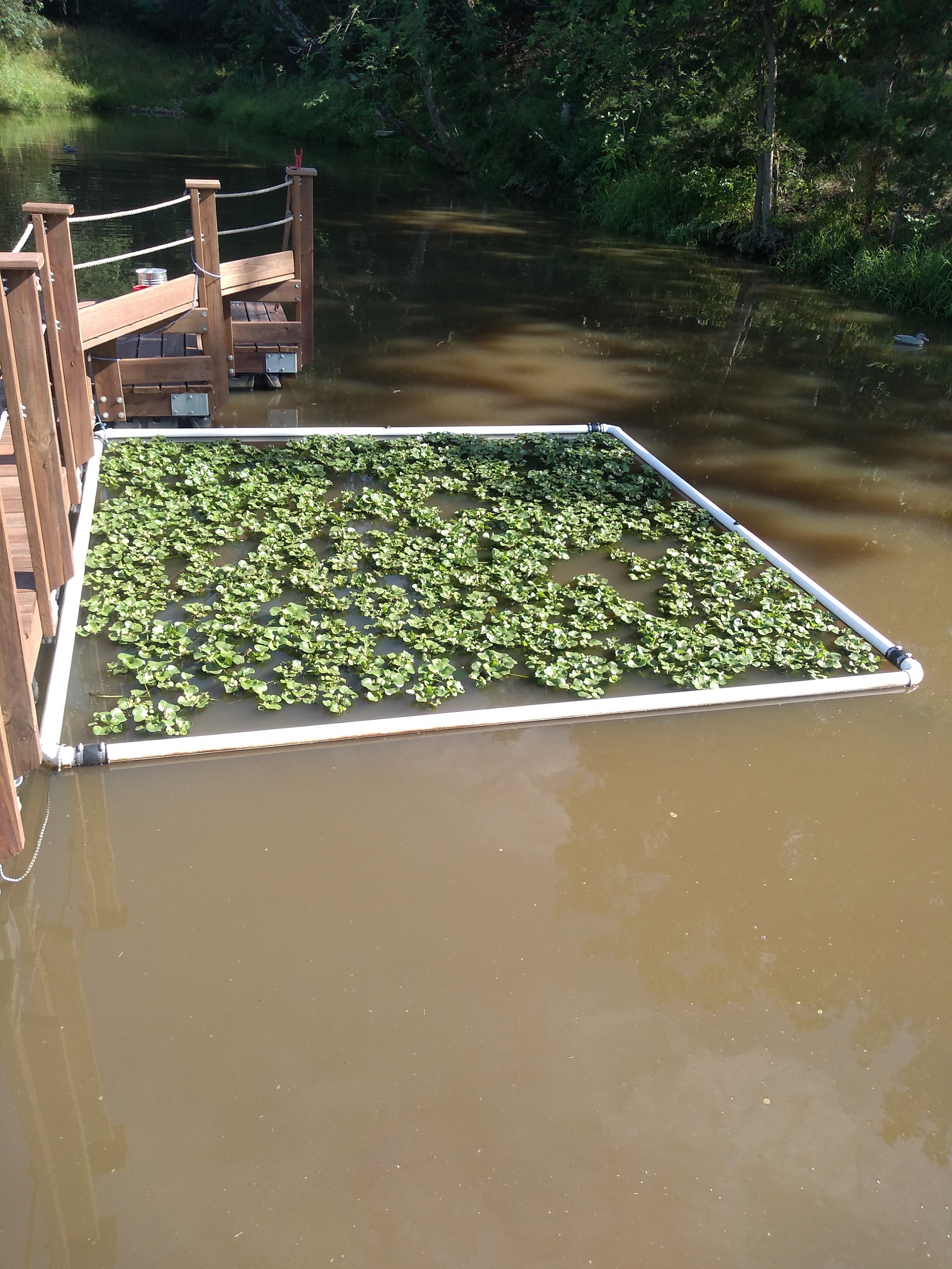
Holy...
Those things have really blown up. Mine haven't even doubled yet.
Holy...
Those things have really blown up. Mine haven't even doubled yet.
They are really liking the surface temps of upper 80's and my muddy looking water. What's your surface temps in NW Kansas? What about your turbidity? Your more than welcome to some of these if you think it's a variety difference. I'll be culling in a week or so.
You better put up a higher fence bud!! Them critters 'bout to be climbing out!!
Seriously...they are looking good! You'll really love them when they blossom. Have to be one of the prettiest flowers in the world.
Holy...
Those things have really blown up. Mine haven't even doubled yet.
They are really liking the surface temps of upper 80's and my muddy looking water. What's your surface temps in NW Kansas? What about your turbidity? Your more than welcome to some of these if you think it's a variety difference. I'll be culling in a week or so.
I barely make low 80's here on the surface.. in a long hot spell we might see 85 but we have 58-64 deg nights so it just doesn't heat up and stay there very long. Last week we had 2 nights in a row below 50..47 and 49 I believe.
I barely make low 80's here on the surface.. in a long hot spell we might see 85 but we have 58-64 deg nights so it just doesn't heat up and stay there very long. Last week we had 2 nights in a row below 50..47 and 49 I believe.
I bet that is what is holding them back. I put the plants in my pond as the surface temps got above 70 and they really did not show strong growth until the mid 80's. Now that it's upwards of 90F, they are exploding.
According to Wiki...
"The temperature tolerance of the water hyacinth is the following; its minimum growth temperature is 12 °C (54 °F); its optimum growth temperature is 25–30 °C (77–86 °F); its maximum growth temperature is 33–35 °C (91–95 °F), and its pH tolerance is estimated at 5.0–7.5."
This seems to be matching my observations. I do envy your nighttime lows, we have been seeing low 70's at night and muggy humidity...Stymie first thing in the morning, then the sun comes out!
Interesting..
I can say that although my plants may be a bit slower, My SMB and YP are flat packing on the weight. I'm extremely pleased with growth rates right now. I checked 2 SMB yesterday that were 136 and 141 WR, 1 YP that was 122 WR so I can't complain..
I do have another variety of hyacinths that I'm going to try just to see how they compare but I don't have a variety to tag it with.
Snipe, Good to hear that your fish are going gangbusters. Those RW's are fantastic! You should add some more photos of your plant's progress when you get a chance.
Here is today's progress photo. The WH seem to have slowed down some and are looking a little ragged. Some kind of bug is eating at them, FA is growing on the roots, and none seem to get very big. I really expected to be culling them out by now. The 10x10 corrals are not quite full, but close. They have come close to doubling in 11 days.
I did find two rouge plants today as I was netting out some pond scum. They were very small, about silver dollar size. Maybe turtle action helped them escape. No sign of any rouge colonies as of yet, however.
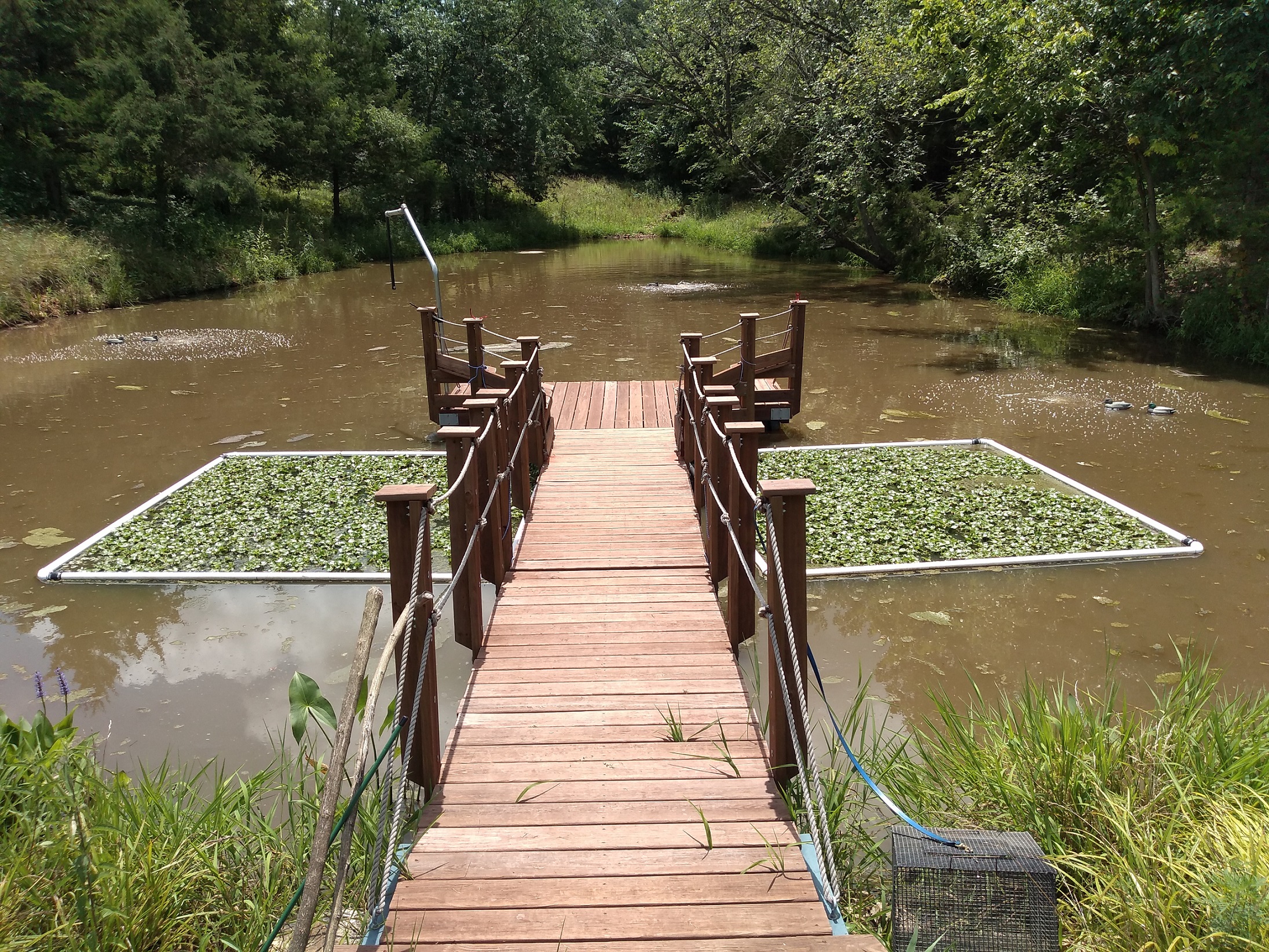
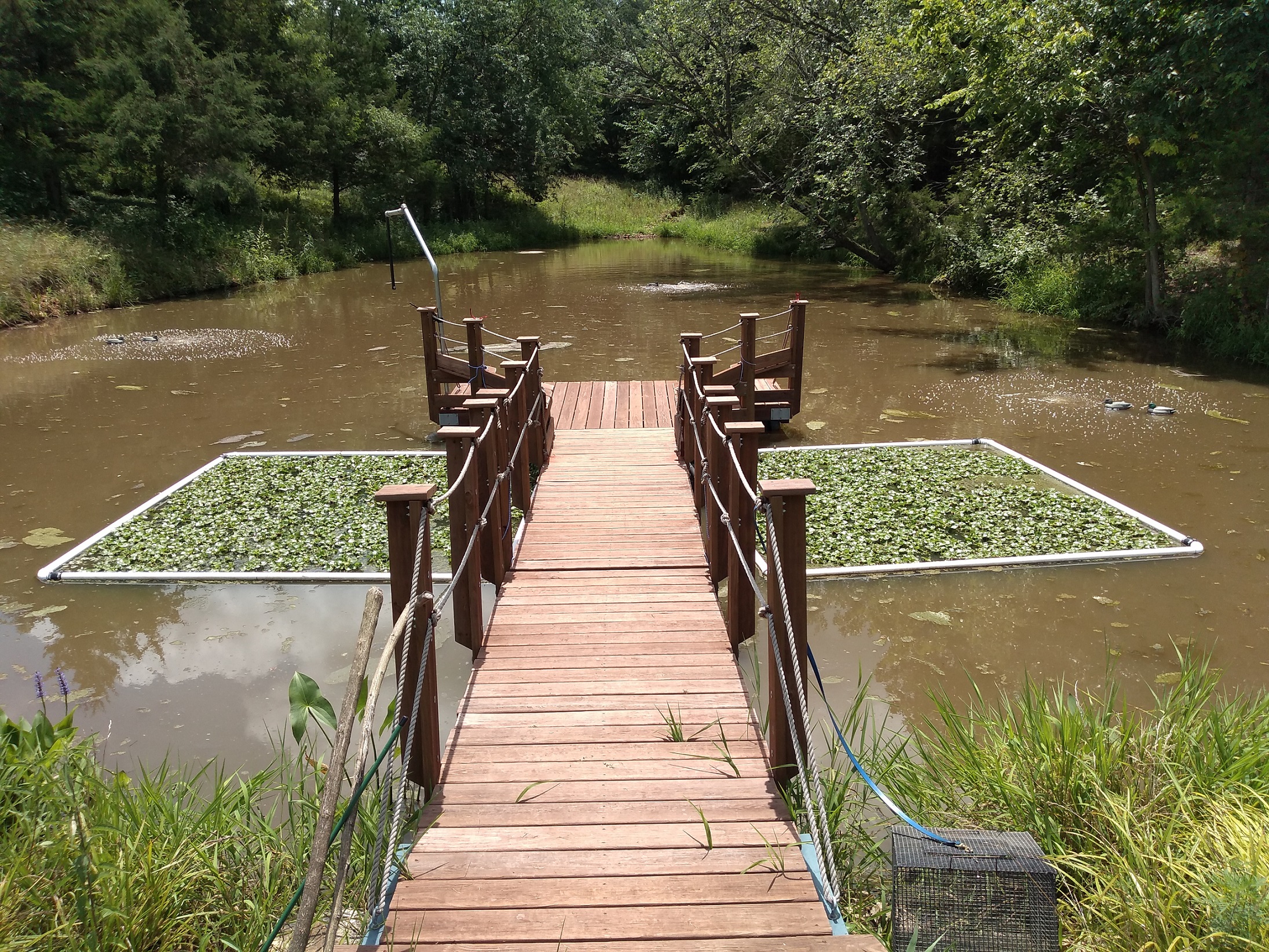
I dont know if they exist where you are, but there is a weevil down here that feeds on floating plants like WH and Salvinia. They obviously arent able to keep up with either plants' explosive nature, tho.
Could be something like these critters have found a new food source in your pond.
That is just unreal... My plants have not spread to cover half of the 36sq ft floaty pen. I should have some plants from the other source tomorrow and my water temp is up to around 82 now so maybe they will take off. Biggest problem I see is FA completely engulfs my plants, I have to pull them out and remove as much FA as I can from roots-which it's impossible to get it all. I've filled my 16ft boat 3 times now with FA removing it until boat is almost under water. I've spread most of it up by my shop to dry, then haul to my mother in laws to work into garden. If I have to load boat again, I may resort to chemicals. I can't imagine what it would be like without Tilapia (150 4-5").
I really admire your pond's natural environment and that dock really compliments the pond shape and design. No matter what happens, you could always go into the dock design and water hyacinth aquaculture business. Very nice!
I've got a similar project (created a floating island with feeder on it) going with water hyacinth, but mixed in cattails as well. My cattails seem to be spreading faster.
I don't see any of the bugs, but many of the leaves have little holes in them. Either way, they are not doing much damage and the bugs are not near keeping up with the growth rates.
Snipe - We need a pic of you in the sinking FA barge! That sounds like alot of work and some nervous moments. After looking at the pic of your plants...I wonder if I did not receive some dwarf variety. Mine are not getting tall at all and the leaves are staying pretty small compared to yours. That or my waters don't have what the WH need to grow big, just fast. I think yours will be taking off with the warmer temps.
Thanks for the compliments Joey! If I could keep my standard of living messing with other people's ponds I'd be a happy man.
NEDOC - post some pics please. I am curious how you mixed the floating plants with the emergents (cattails) on your island.
I noticed that about your WH too Noel. Not very big compared to what runs wild down here. Some of this stuff gets close to 2' high and as big around with really broad leaves.
Ok, here's my floaty and pics of start and today.. Not even close to what you have taking place.. I think it's around 30-35 days, I'll go back and look.
Edit: 31 days today.


Quick Update: I have started culling plants this last week. I have removed four 5 gallon buckets worth since and expect to remove at least 6 every week until their growing season tapers.
It is amazing how much muddy-looking water runs out of the roots as I pull them from the pond and throw them in the bucket...much more muddy-looking than the water directly around the plants. The roots not only absorb nutrients, but they seem to attract and hold solids.
No flowers have shown up and their size is still on the small side. I am convinced that "they" sent me dwarfs. I'm not really complaining because larger plants might be harder to corral especially if they got anywhere near 2' high. I'd still like to try the large plants, maybe next year.
Good stuff QA! Thanks for this thread!
Have you noticed a difference in water clarity or is it too early to tell?
I was afraid someone would ask that...There are too many variables in play. Between the multiple algae blooms, periodic inrushes of rain water, me tromping around in it, Aeration timing changes & repairs and so on...there's no way to tell if it's doing anything other than just KNOWING it's doing something.
My water clarity has been around 12" all year long. Possible contributors are...
Lots of crawdads,
Possible carp hitchhikers,
Floaty clays being kicked up by aeration,
and heavy algae blooms.
The good news is there is not more than few hand fulls of FA in the pond. It can only grow right at the surface, typically on the upper most Hyacinth roots and any grass that falls over in the water from the bank.
I have a severe coontail and algae problem (covering 75% of the 3 acre pond). I'm treating it with herbicides and getting carp/tilapia but I also wanted to explore planting some vegetation on the shoreline to absorb the nutrients before it gets to the water.
What are some good plants to plant in the shoreline that won't invade the water?
Quick Update: Culling continues and I am averaging about one 5 gallon bucket a day. I actually pull two buckets out of an evening (one form each corral) every other day or so. The other day I pulled plants two days in a row because I was not going to be able to get to the pond for a few days. I have taken to culling the smaller bug eaten ones. The smaller plants seem to also be more susceptible to being overgrown with FA on their root systems whereas the roots of the larger plants hang down further than the FA grows.
Water temps in the pond have been about 80 top to bottom with the aerators running 24/7.
Still no flowers.
It’s amazing how much those things are growing! Any scares regarding release from the corrals?
Will you try and hold the over for the winter if you find some successful outcome to your experiment?
I have found 3 or 4 small plants that have escaped. All of them were found very close to the corrals and put back in. There has been no signs of rogue colonies however.
The WH can be wintered indoors, but most say that success is low unless you can really supply good conditions (better than my dark basement). It's not as easy as wintering bulbs and for 20$, I will just buy some to start it off again next year and avoid the cost, time, and electricity for light that's involved with setting up the indoor green house.
Here's an image of the root system of my floating island in my grow out pond. It is simply 3' x 5' wire mesh with pool noodles zip tied around the edge. About 6 weeks ago I uprooted some cattails and laid them in there. It takes a while for them to establish but now they are going crazy.

Here is my floating island that I have built with plans of putting a Texas hunter feeder in the middle of. It's 15' x 8' and made out of treated 2x4s, 1x4s and expanding foam. Total cost to build was around $300. If this works out and provides refuge for fish the way I hope I'm planning to build about 2-4 more.

As a side note/question..... Does anyone have a guess as to whether the cattails will survive and start over again next year if I just anchor my floating island in the pond and leave it in the ice over winter?
I have a severe coontail and algae problem (covering 75% of the 3 acre pond). I'm treating it with herbicides and getting carp/tilapia but I also wanted to explore planting some vegetation on the shoreline to absorb the nutrients before it gets to the water.
What are some good plants to plant in the shoreline that won't invade the water?
Sorry platon...I missed your post.
I'm not that good with plants, yet. All I can say is look for plants that are common in your area (at nearby ponds) and identify them. Marginals or emergent plants will, most likely, be what you are referring to when you ask "What are some good plants to plant in the shoreline that won't invade the water?" In general, these plants will stay close to the shoreline so long as the water does not stay shallow (less than 3 foot) for very far out into the pond. Plants like Arrowhead, cattail, Pickerel Weed, and Thalia Dealbata are ones that seem to like my pond at least. I pull any cattails that show up so that the others I mentioned can get more established, but cattails are likely to be one of the best plants to reduce erosion and take in nutrients, but the can be pretty invasive too.
Replacing the stock every year probably makes the most sense. I did a quick search on the googler to see if there is a specific reason why you might not be getting flowers:
https://www.youtube.com/watch?v=1-QKEeQQEyMIt is one data point, but the short story is, it won't bloom in high nutrient environments. It must need some stress to feel the need to pollinate and sexually reproduce, otherwise, maybe it is content in high nutrient environments to just clone and make as much vegetation as possible, going crazy and neglecting bloom until it feels the need to go dormant.
If you're using them to strip nutrients from your BOW, you will likely not ever see them bloom, or if you do, it may be time to take them out!
Your setup is still visually appealing, even without the flowers. I think the symmetry around the dock and the geometric shape of the corral makes it look ornamental and aesthetic.
@Snipe. That may correlate with the difference in growth rates you're seeing. You may get less vegetation, and therefore be more likely to bloom. I would assume that a bloom would correspond with seed production, maybe?
As a side note/question..... Does anyone have a guess as to whether the cattails will survive and start over again next year if I just anchor my floating island in the pond and leave it in the ice over winter?
Fantastic addition to the thread NEDOC! Thanks for posting those pics.
I can't help but think that the cattails will survive
IF the bulk of the root system is below the ice, but only time will tell. Certainly try it and post back to this thread. If the ice gets to the upper sections, the lower "alive" portions might rot off and sink...IDK
Does your floating mesh and noodle islands float out in open water or do they require being in the shallows? I can see them getting heavy and lop-side sinking. I may have to steal that idea next year and try some cattails too.
Got one to bloom, QA!!!

Very good Snipe, maybe mine are not far behind.
Beautiful flowers.
As a side note/question..... Does anyone have a guess as to whether the cattails will survive and start over again next year if I just anchor my floating island in the pond and leave it in the ice over winter?
Fantastic addition to the thread NEDOC! Thanks for posting those pics.
I can't help but think that the cattails will survive
IF the bulk of the root system is below the ice, but only time will tell. Certainly try it and post back to this thread. If the ice gets to the upper sections, the lower "alive" portions might rot off and sink...IDK
Does your floating mesh and noodle islands float out in open water or do they require being in the shallows? I can see them getting heavy and lop-side sinking. I may have to steal that idea next year and try some cattails too.
They float in open water. My pool noodle island is in a 600 sq ft grow out pond, so it just goes whichever way the wind blows, never rooting down. Oddly the plant growth above water seems to not impact the balance and buoyancy of the island at all. No idea why. I'll keep updating with pictures every few weeks as my larger island is progressing quickly recently.
BTW, I was thinking the same regarding the roots staying alive if they stay below the ice.
BTW, I was thinking the same regarding the roots staying alive if they stay below the ice.
Consider sinking one of the noodle islands so that the bulk of the root system is below the freeze line for the winter. Maybe not the best idea if you only have one island, but it's got to be better than letting it reside where the ice will be.
I’ll probably see how deep the root system is after the summer and go from there. Right now they have to be approaching 18” long. That should get them through most Nebraska winters.
Very good Snipe, maybe mine are not far behind.
Beautiful flowers.
QA, if you have a little time, maybe keep two or three of your cloned plants in a 5 gal bucket for a few days until they use up the nutrients and see if they bloom. I think there is a direct correlation between vegetation growth and the lack of bloom. You may be able to force it into action.
Snipe's photo doesn't seem to show near the aggressive cloning reproduction that yours did.
As much as I like the flowers, I am a bit concerned about the seeds getting into the pond and germinating next year (some say that they will reappear the following year near my hardy zone and the seeds can stay viable for 15 years). So, no flowers at the pond would be sad, but a relief also. I will throw a couple in a bucket next time I cull and see what happens.
Snipe is quite a ways further north of me which may have something to do with the slower reproduction (cooler temps), but he may not have the available nutrients like my muddy hole has.
As much as I like the flowers, I am a bit concerned about the seeds getting into the pond and germinating next year (some say that they will reappear the following year near my hardy zone and the seeds can stay viable for 15 years). So, no flowers at the pond would be sad, but a relief also. I will throw a couple in a bucket next time I cull and see what happens.
Snipe is quite a ways further north of me which may have something to do with the slower reproduction (cooler temps), but he may not have the available nutrients like my muddy hole has.
My hyacinth are growing and spreading much quicker in my large nutrient rich pond than in my grow out pond where I flush fresh water through regularly. FWIW.
Thanks FLX...as you mentioned in another thread, your video post got buried and slipped by me.
It's really interesting at my recently renovated pond (3 years ago) . I have always considered it high in nutrients, but without much science to back it up. Mainly because it's always muddy, it can grow some FA where any light penetrates, cattle pastures in the watershed, and consistent algae blooms where some get kinda scary. My latest test results indicated ZERO nitrates, ZERO phosphates, and just bit more than Zero ammonia. DO levels are OK, but not great (5-6ppm) and the pH is almost always perfect (very near 7).
With the WH flowering aspect weighing in from your video, it suggest high nutrients too, but I don't think my test results suggest that. Either way , removing about a bucket a day seems a bit low because at one time they were doubling every week or so and they seems to have slowed down with no blooms. I still wonder it the FA is choking the smaller ones, but I don't have the gumption to manicure them.
As they say about 2nd year ME students after they have passed a statics course, I know just enough to be dangerous.
It sounds like the WH are a fun addition to your eco-system. As long as they don't get out of hand, they have to be contributing to the "balance" of the BOW.
I'll be looking back at your log posts to see what I can learn. there is a lot of info there. YAY DATA!
Culling has slowed to about four 5-gallon buckets a week. I'm not sure why. My guesses are...
1.) The root systems seem to be crowded or saturated with dirt and nutrients even though I manage to keep some (5-10%) open space in the corrals. The coral closest to an aerator (10-15 feet)is outperforming the other in quantity, quality, and size, but not by much.
2.) Nutrient levels in the pond are lacking (theory), but I have had no flowers to date. Test results show zero (to near zero) nitrates, ammonia, & phosphates, but there as been ample surface scum/blooms this year.
3.) I may have been sent dwarfs...do they exhibit less aggressive growth compared to the standards?
All in all, the weather and pond temps have been right were they like it. I'm not complaining, just curious about their tapered production rates.
I have put a few plants in a bucket of well water to see what they do. I suspect that the bucket will get pretty hot during the day which may affect the outcome, but putting them in the shade would too...so, it is what it is.
Edit: added photos for the record...
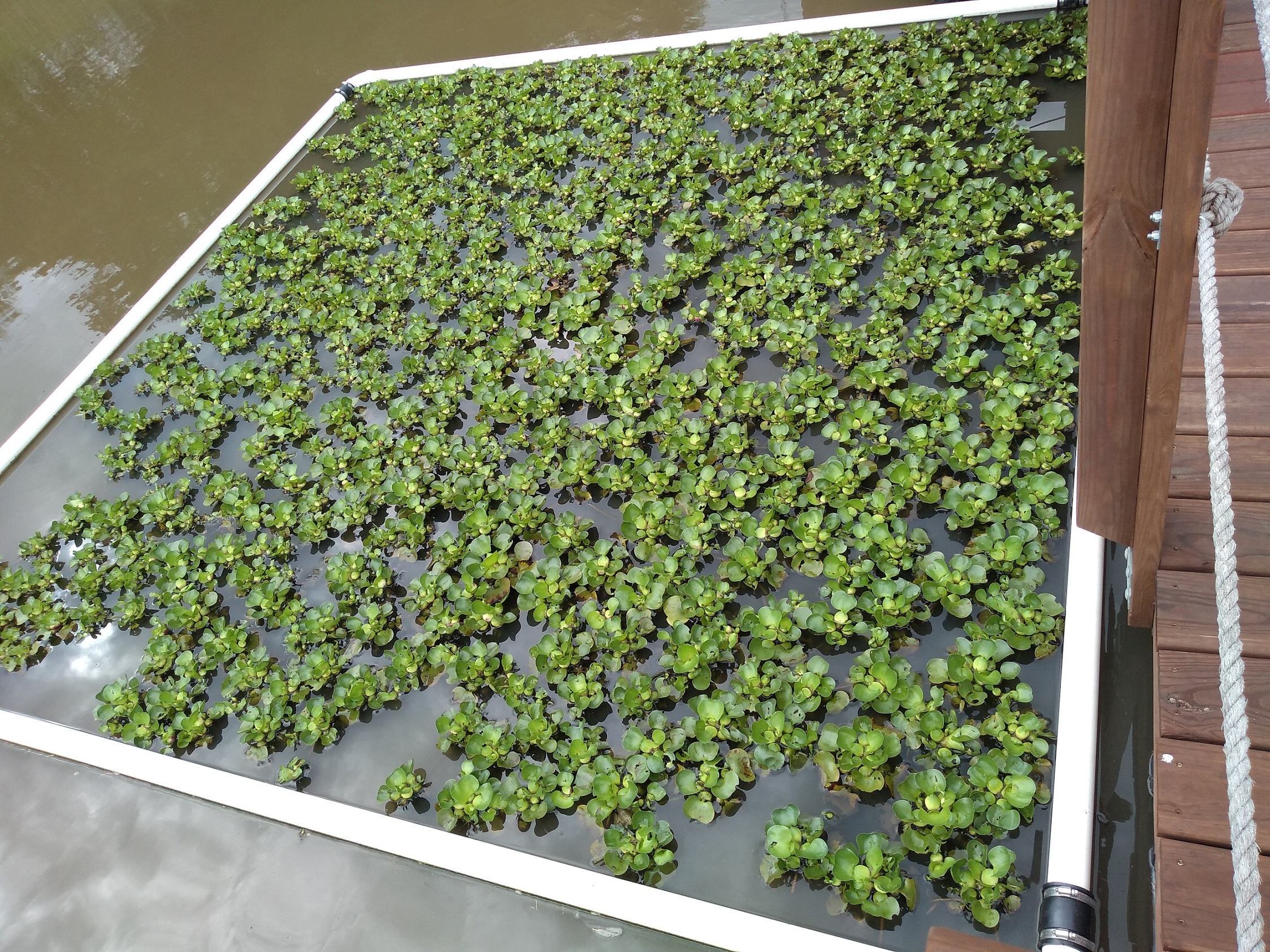
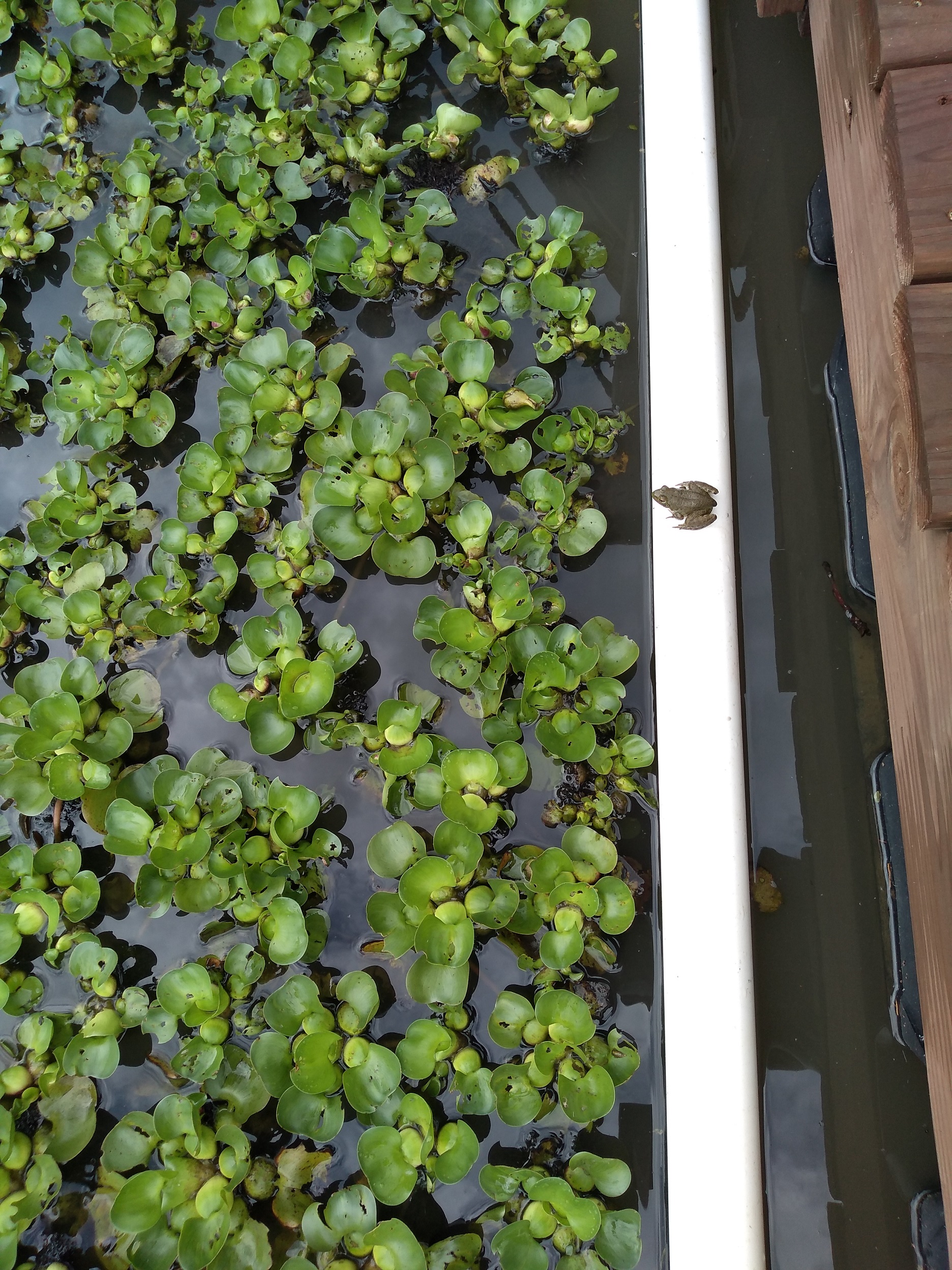
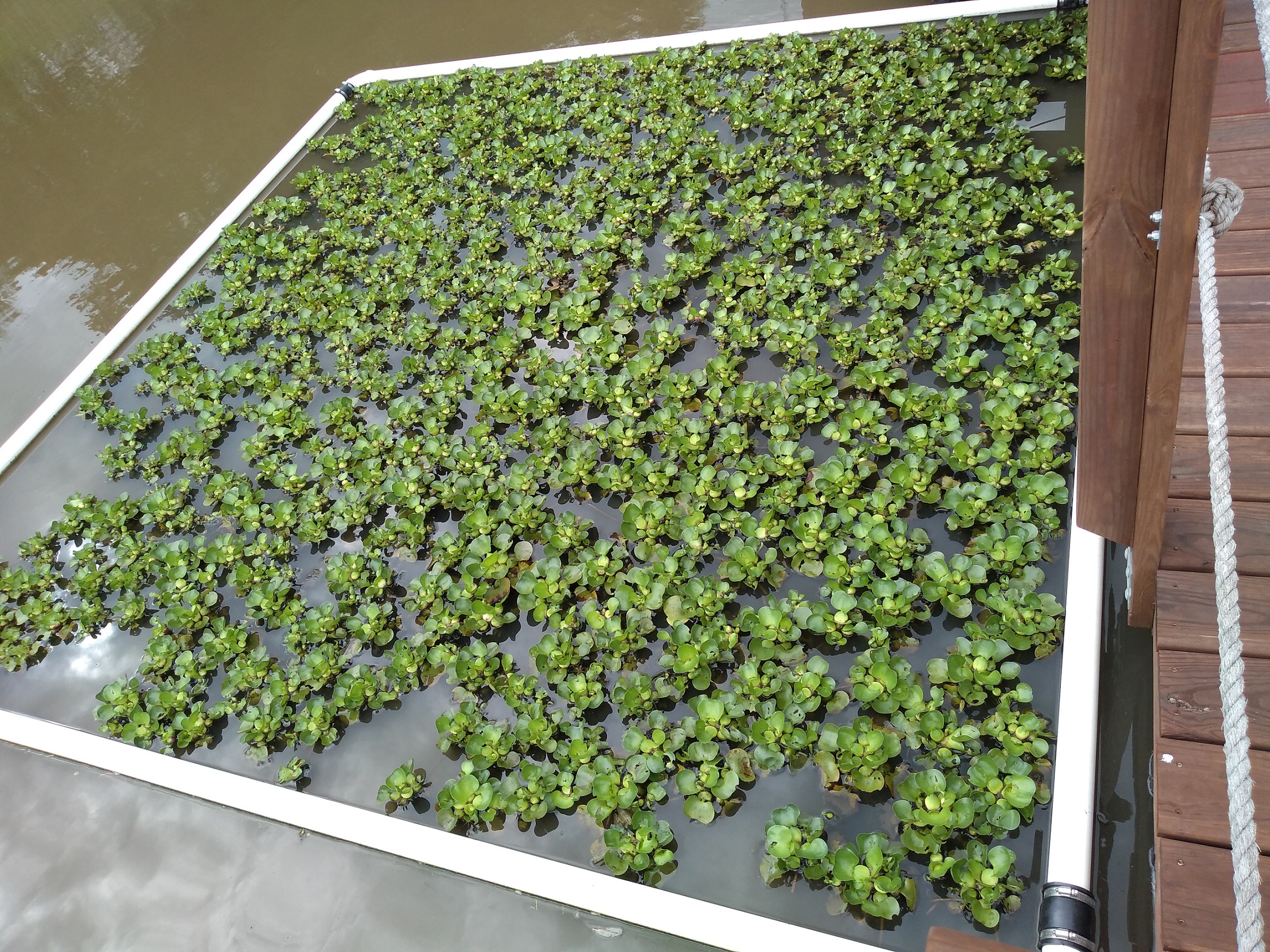
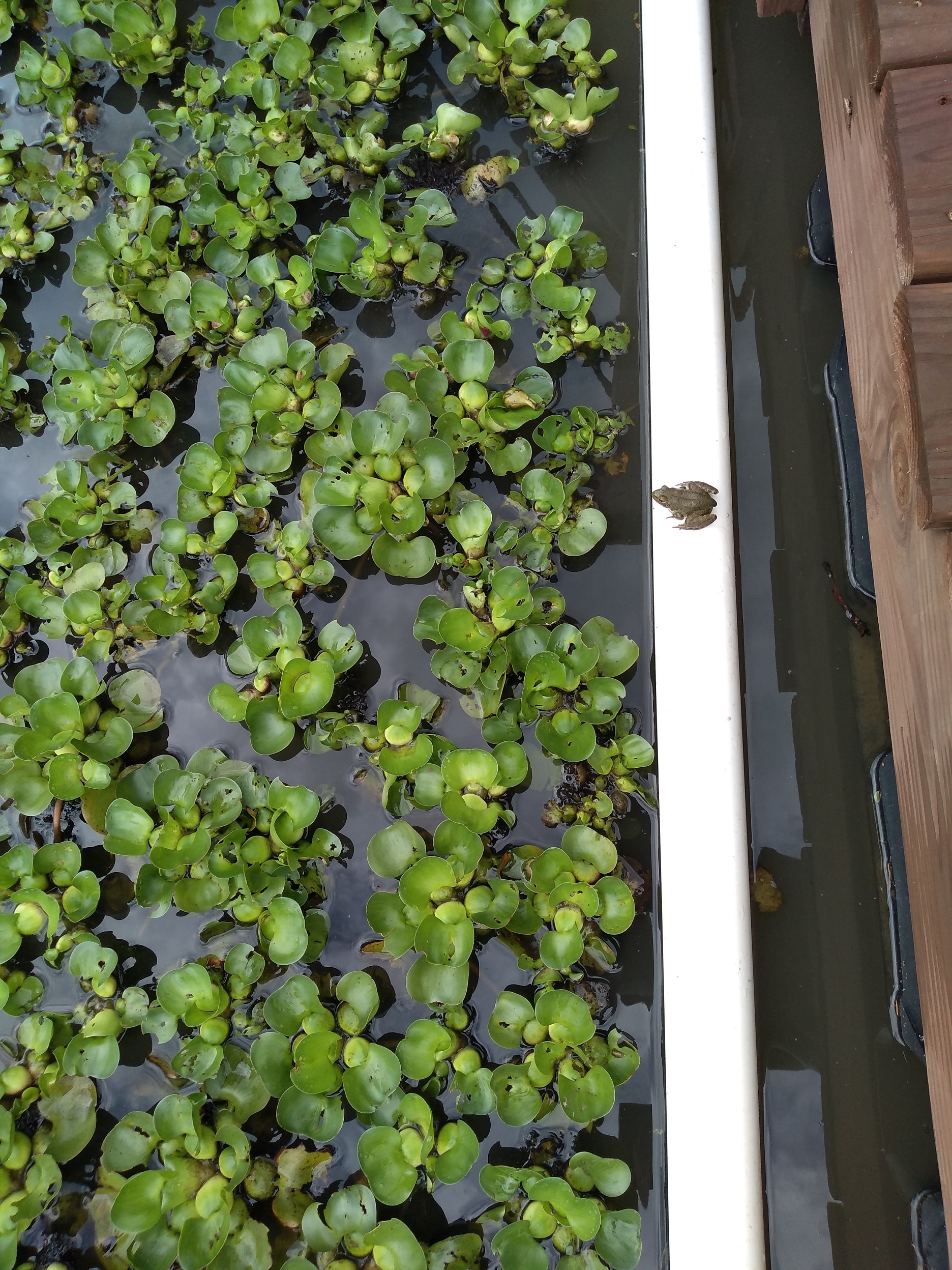
I’ve put some in my grow out pond that I cycle water through regularly to manage nutrients and I get very little response from wh. In my larger pond that is nutrient rich they grow like crazy. I’m thinking those in your bucket may not do much.
There's a possibility that the WH blooms when nutrients run low, so, I have put some of my culled plants in a bucket with well water to see if they bloom sooner than the ones in the pond (or fade and die).
Mine has really taken off now. I'm about to mount my Texas Hunter on it and deploy it.

After my flood... check out the color and vigor of these since flood..
Nutrients were very obviously lacking before.
Probably doubled in 2 weeks.

Nutrients is certainly a key factor. Your plants look real nice!
It has been an interesting year at my pond and the WH have been a useful tool to back up my water quality tests. It would appear that my pond lacks nutrients, at least at certain times of the year. I look forward to next spring's water testing to further my knowledge of my BOW.
I am a bit on the fence whether to put the WH in next year or not. Maybe just less of them or only in the early summer...IDK. The early season water testing may help make that decision. My land leaser fertilizes the pastures (~ 15 acres in the watershed) in the spring and that may have caused my early obnoxious blooms. For the last month the water has been relatively bloom-less.
One of these days I will have my pond "meistered"! maybe.
QA, I haven't taken a pic but mine literally grew out of my floaty fixture. Now they are all over the pond in 3-4' groups. Only 2 flowers ever seen and I'm going to just let them go until the cold hits. I think I had actually burned most of the nutrient load up before the flood because the WH looked so poor and really didn't spread much. After the flood, they got huge, turned bright/deep green and exploded. I believe there is a limit of nutrients they can pull that is still above a clear (cleaner)-water situation where plant life slows. I just hope my Sago comes back, flood just cleaned it out.
Snipe, I culled several buckets last night as I had not done so in several days and I can see how, if left to their own, they could expand so much that they push out under the corals. I removed about 4 buckets worth from one of the corals, fluffed the remaining ones a bit, and the coral still looked full. More to come out tonight...sure wish they could go to a good home...anybody have a pet hipo?
Odd thing about this years experiment is that when the pond supposedly had higher nutrient levels, the plants reproduced well, but lacked the aesthetic vigor. Now that I have been testing the waters and shown little to no nutrients...they are looking much better and showing a bit more reproduction. I guess, in my pond's environment, that air and water temps may be playing a strong role in how happy they are.
Very similar response here QA. Seems as though they’ve really gone crazy the last 3-4 weeks.
NEDOC and QA, Maybe the flood I had was coincidental in that I assumed the blow-up of growth was new, higher nutrient levels when it was actually cooler night? Not sure but the 3-4 weeks falls right in line with the explosion of mine as well.
Noel, your WH pics scare me to death. I've seen them take over a favorite BOW in Texas, and their seeds are viable for over a decade!
But it's a clever idea where you get hard winters that kill them off. If you get a warm winter, though, look out. Especially when they flower!
Noel, your WH pics scare me to death.
I have to say there is a small bit of fear in me too.
Using my growth rate findings this year, I have made a very rough estimate...left alone, the WH could have filled my 1/4 acre pond in 3 months. Certainly, in one Missouri growing season the pond would have been packed full.
The "one bucket per day" culling rate is increasing quickly and the corals are becoming more tightly packed. If it keeps up I will be removing 2 buckets a day.
I may opt to cull any flowers that show up, if they ever do. Even though (I'm man enough to admit)...I like flowers.
It's been a month since my last posted pics and it won't be too long and a photo op will be no longer be an option as we are nearing the first frost. I have decided to remove the WH this week...half were taken out yesterday.
Overall, this years experiment has proven to be pretty cool, but probably not necessary. I really started paying attention to the water quality in the pond mid summer and came to the conclusion that the pond did NOT have high nutrient levels as I expected. Turns out the pond was just muddy due to an overabundance of crawdads and had some freak algae blooms.
I wonder what these monsters would do in a really fertile pond? I may do them again next year, but in one - 5x10 corral instead of two - 10x10's. They never even tried to flower which could be a good thing seeings how the seeds are supposed to stay viable for many, many years. I'm still not convinced that they would germinate in my area, but I'll leave that to the experts.
Next year, I want to try some pond lilies in hanging baskets off the dock and will need the real estate for the lilies.
I will stick to my estimates that I removed one 5 gallon bucket a day on average right up to the end. During the heat of the summer was a bit less, but the last few weeks were a bit more and the health of the plants were the best after the heat of the summer waned. What I can not truly explain is...the plants seem to double their square footage early in the season about every week or two...by all accounts, I should have been removing alot more of them once the corrals were full. Maybe they are programmed to slow down reproducing once they feel confined...I Don't Know!
Anyhow, here are the last photos for the year...Hope you enjoyed the season!

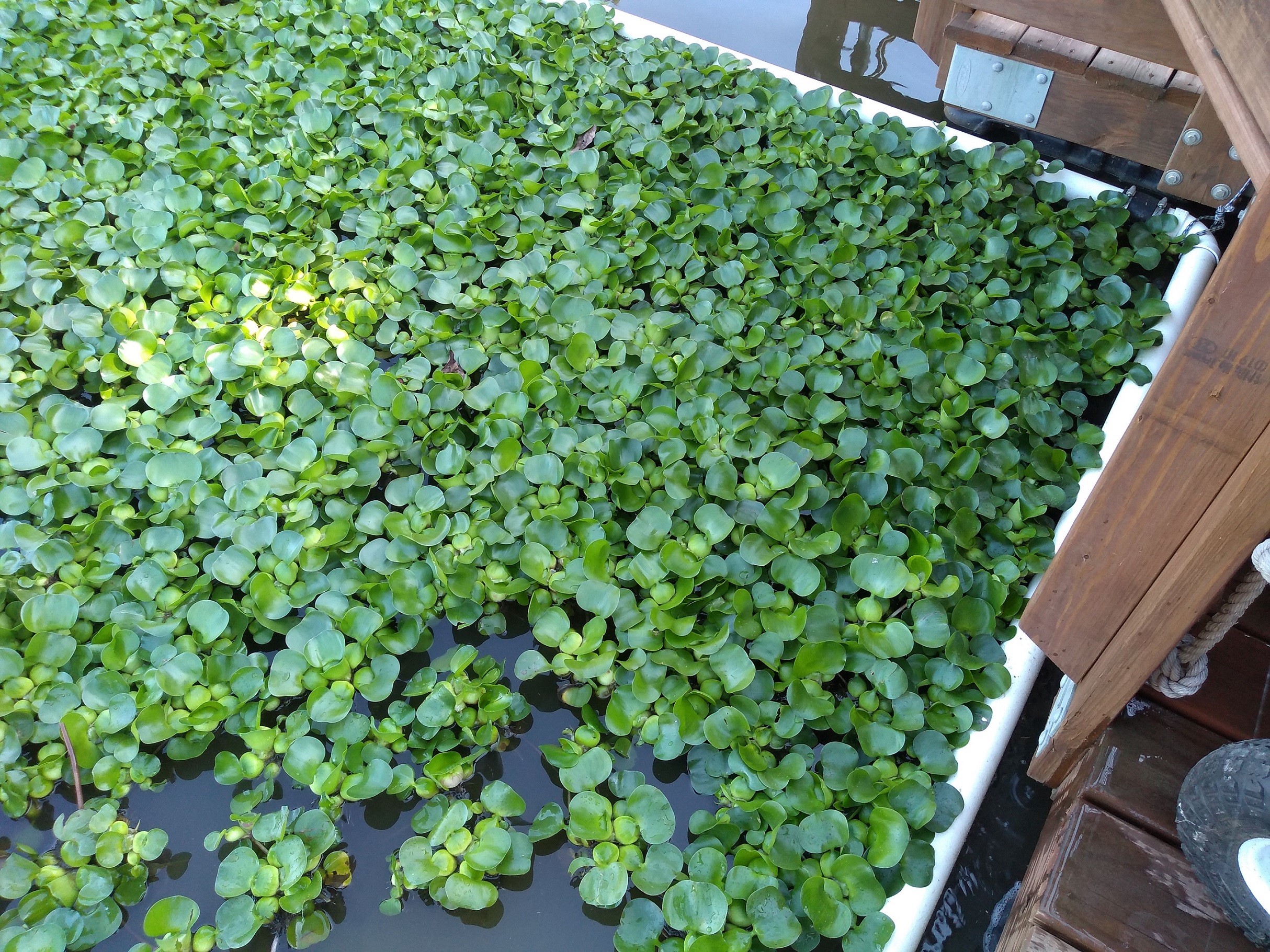
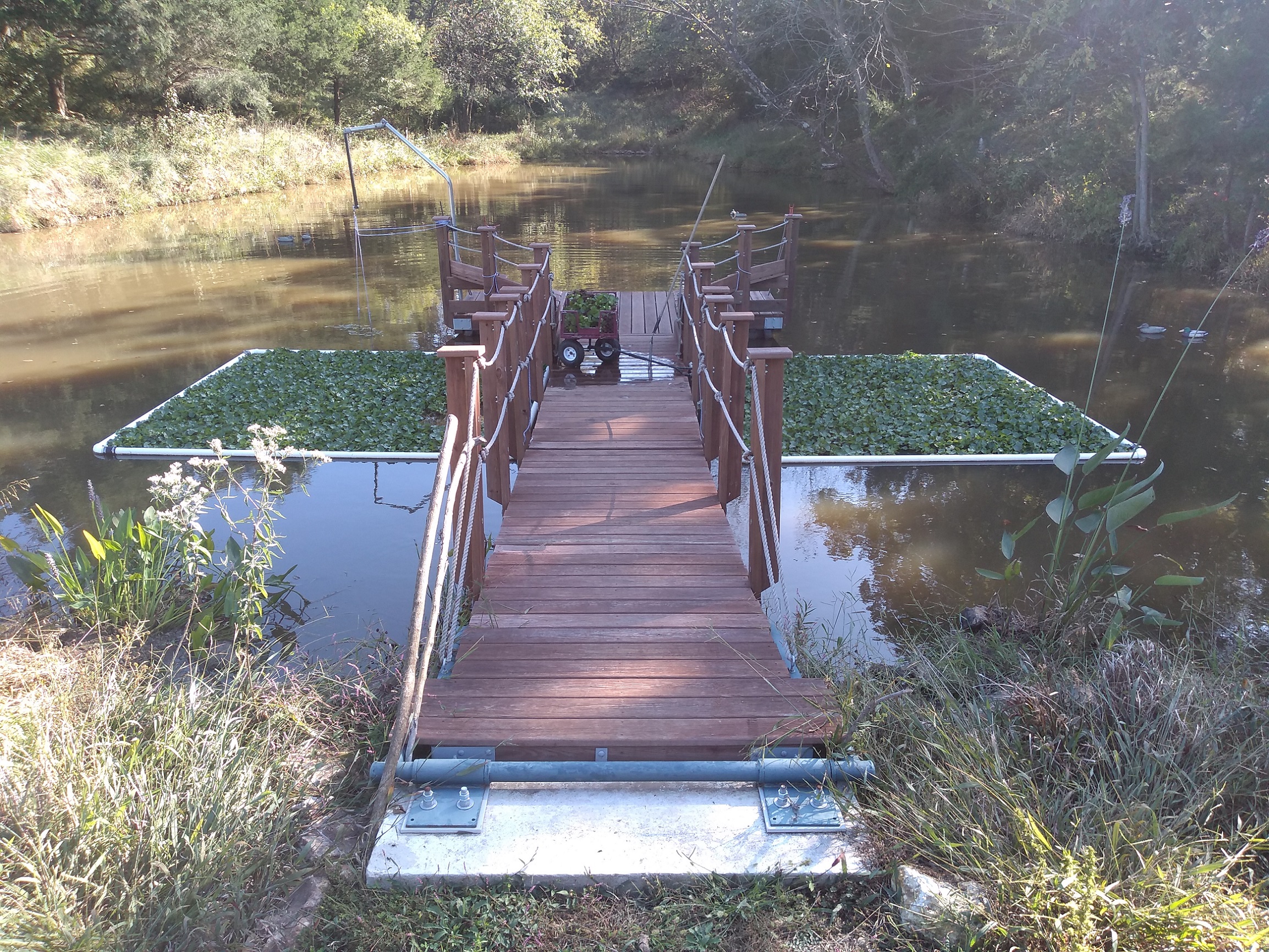

QA, we've had 2 hard freezes now and my WH don't really show any discoloration?
I'm going to leave them and see what changes I see.
Tonight and tomorrow night are supposed to be down to possibly teens but low 20's for sure.
In fact possibly some decent snow.. we'll see.
Have you tired keeping them inside of the winter? I just went out and scoped mine up. Just had a few lil starts just a few weeks ago. Going to leave them in the shop over the winter. I plan on changing the water out every so often. I dont know if they will make it or go crazy iv never had them before. Not 100 percent sure these are them same or not but I think so.

Look to be very similar.
I've had 4 nights in the last 10 days below 32 and funny, they don't show any signs of damage.
It's 21 right now and headed to 15 they say tonight so I'm guessing that'll toast them.
RS - Those sure look like WH and I have not come across a "look-alike" yet.
I have done some internet research on overwintering them and found a couple forum posts that mentioned good luck with it aside from a climate controlled green house. They put about 4 inches of pond mud in the bottom of a 6 inch deep pan, nestled the plant's root system mostly in the mud, topped off with pond water, kept them in a room above 55-60 degrees, and used shop florescent lights and a timer to give them some light. I can't remember what the light cycle was, but I'd bet on 12 hr on/off.
Most of those that tried it would fail about February as the plants would just slowly fade away, but the above explanation seemed to yield the best results. They also mentioned to NOT fertilize them. I would guess that they need to be kept in a somewhat dormant state and fertilizer would try to pull them out, but due to lower temps and the lack of true sun light...they'd burn.
I was going to try some in the dinning room by the sliding glass door, but a container nice enough to satisfy the little lady would cost more than ordering a few next spring. I'm lazy and tight that way! Not to mention, I'd probably forget to check on the water level and it'd just be a waste.
Snipe, I will be taking the last corral's worth out this weekend. I don't need what nutrient soak that they provide and I do not want to be doing it in any colder weather than I have to. I'm. also not a cold weather fan...it appears you have no choice in the matter...teens in October...jeez! I would bet that the surface water temps create a blanket of warmer air that protections them going into fall for a short period. 15 degrees will surely get them, however.
So will they come back on there own? Kind of sounds like they have a bunch of seeds. You know how to get the seeds out?
RS - WH produce flowers (except mine did not this year). These flowers will produce the seeds. Some folks from the Midwest have said that their WH have come back on their own in their pond from these seeds.
EDIT:
I have found the one thread where Dale (dlowrance) from central Illinois and you (RStringer) have them reoccurring from year to year by seed...
http://forums.pondboss.com/ubbthreads.php?ubb=showflat&Number=503633
Is this your first year with them. How far are you from me. Parsons ks here.
Mine that were floating freely around the bank were trapped in a thin layer of ice this am... I'll take pics of them as they change, I assumed it would burn the crap out of them but still green now.
We got down to 39 last night. That's the lowest so far. I think the forecast is a low of 30 tonight. So should I leave them in the pond? Do they have a better chance of making it thur the winter in the pond? I would like a bunch of this but also dont wanta buy it. I'm not really a cheapskate I just like doing things in my own.
Is this your first year with them. How far are you from me. Parsons ks here.
According to google...Parsons KS is 3 hours and 40 minutes from where I live (north of Sedalia Mo). And, this was the first year with the WH in my pond.
I might take half of them back to the pond. These will almost make a moble riprap. Since they float around it seems they will go in the direction the waves are going. Should slow down the erosion of the constant waves. I am wrong for thinking this? I have a buddy that leave in Jefferson. Some of the landscape up there is very nice looking.
Do they have a better chance of making it thur the winter in the pond? ...I just like doing things in my own.
I would take some inside now if you want to overwinter them. I think the odds are against any left outside surviving. You might get some to pop back from seeds if they were produced by the plants this year and are nestled in around the pond banks out of reach of mother winter, but I wouldn't count on it. There's a reason that they are not considered invasive this far north.
EDIT: I found an older thread of mine where you (RS) have them coming back every year. I wonder what makes your pond conducive to seed germination???...the proof is in your pudding!
Here's the thread again...
http://forums.pondboss.com/ubbthreads.php?ubb=showflat&Number=503633

3pm today...

The banana tree and cannas are what I was talking about in that thread. Dlowrance is who had them coming bk. This is the first year I have had them and only bout a month or 2 at tht.
The banana tree and cannas are what I was talking about...
Thanks for clearing that up. Someone wasn't adding up, thought I'd slipped of into the twilight zone.

3pm today...
Looks like 15 degrees will do it to it!
Yeah.. 7:15am yesterday you couldn't really see any difference. When I went back yesterday afternoon that was a bit of a surprise so I'm going to guess the steamy layer on top of warmer water is only good to a certain point.
No worries QA happens all the time to me. I live with 5 female (wife and 4 daughters) so I understand. I live in a twilight zone lol.
No worries QA happens all the time to me. I live with 5 female (wife and 4 daughters) so I understand. I live in a twilight zone lol
Snipe is tht anchored down or they free floating.
QA, I'm interested if any WH plants are starting to emerge this spring in your pond from last years experiment?
I did not buy any for this year. My original suspicion of high nutrient levels was wrong and I have shifted my efforts to lillies and APW.
So, I have seen no WH that survived the winter, but I took all of them out last fall and have not witnessed any rouge plants floating around. The seed thing would be a concern, but I never got any flowers last year. I spent alot of time at the pond and I would have seem them had they bloomed.
Thanks for the update, it was an interesting experiment!
I did not buy any for this year. My original suspicion of high nutrient levels was wrong and I have shifted my efforts to lillies and APW.
I must have missed this. What turned out to be your issue? Crayfish??
My original concerns were, erroneously, high nutrient levels so I thought up this experiment to help reduce the nitrient levels. I based this concern on murky waters, thick funky blooms and a previous outbreak of FA. I also started dabbling in water test kits last year and came to the conclusion that it was not nutrient levels, but muddy waters from the crawdads and excess watershed and clay silts. Water tests consistantly showed low (to none) nitrates and phosphates. Not that I know alot about what I am doing, but this year I decided to not spend the time on the WH since mass plant growth and harvesting the WH seemed like a waste of time. I also have other hobbies that I am stoked about this year (72 Chevy Truck). Instead, I have downsized my plant efforts to a few lilypads and last year's APW that I got from Augie. They are all in hanging baskets off the dock so the craws don't get to them. Heres the hanging basket thread...
http://forums.pondboss.com/ubbthreads.php?ubb=showflat&Number=520474#Post520474All in all, I enjowed the WH and may do it again another year, but for now...I am going to concentrate on the muddy water, crawdad populations, wierd DO levels, and potted water veggies. That's enough for this year I think!



































